Apostle Paul's Final Missionary Journey Map
In the Spring of the year, in Rome, the apostle Paul is acquitted of the charges against him and is set free. He sails from Rome to the island of Crete in order to meet with Titus (Titus 1:5). He then leaves Titus in Crete and sails to Nicopolis (Titus 1:5, 3:12). From Nicopolis he writes the New Testament books of 1Timothy and Titus.

63 A.D. to 67 A.D.
Paul continues his mission of spreading the gospel by traveling to Spain. In the winter of 57 A.D. He writes to the church at Rome regarding his planned travel to this western part of the empire.
For this reason also, I have been hindered many times from coming to you (the believers in Rome Paul had never visited). But now, there being no place in these regions that has not heard the gospel, and having a great desire to come to you for many years whenever I may go to Spain, I will come to you because I hope to see you while passing through Rome . . . Therefore, when I have finished this task (delivering aid to poor saints in Jerusalem), and have safely delivered into their hands the fruit that was collected, I will set off toward Spain and will come to you (Romans 15:22 - 24, 28, HBFV).

There is also evidence, though not conclusive, that Paul also preached the gospel in Britain (Britannia).
68 A.D. (January or February)
Paul is likely arrested and imprisoned in Rome in the early part of 68 A.D. In the spring he writes his last book, 2Timothy, addressed to his greatest friend ( Life and Epistles of St. Paul , appendix III).
Paul is beheaded, under Roman Emperor Nero, around May or June. His death occurs just before Nero's suicide on June 9, 68 A.D. in Greece. He is about 66 years old.
Nero is the first emperor of the Roman Empire to actively persecute and kill Christians. Rome will carry out at least ten major efforts to exterminate Christians and expunge Christianity from the empire. The persecutions first start under Nero in 67 A.D. and continue until 313.
Paul's impact on Christianity will be enormous. During his ministry he wrote fourteen books of the Bible and carried out no less than five missionary journeys. He paid a price, however, for his strong devotion to God and the truth by spending a total of five of his ministry years in prison. He remained faithful to the very end of his life.

Bible Pearls
Did you know that....
The Holy Spirit is one of the most misinterpreted concepts of the Bible. Different denominations of Christianity have different definitions for it.
But, who or what is the Holy Spirit? And is it male or female in the Bible? Is it the third God of the Trinity? Today you can finally learn the truth about this apparently confusing issue.
If you would like to know who or what the Holy Spirit truly is in the Bible and solve this problem, check out our article on this topic in our Bible Articles section, you will find it very interesting.

SIGN UP FOR OUR NEWSLETTER
Related articles you might like.

Paul's First Missionary Journey Map

Paul's Second Missionary Journey Map

Paul's Third Missionary Journey Map

Paul's Journey to Rome Map

Timeline of Paul's Letters and Missionary Journeys Chart
If You Found This Helpful, Please Share. Thanks!

ConformingToJesus Ministry - Copyright © 2014-2023. All Rights Reserved

Paul’s Missionary Journeys: The Beginner’s Guide
by Ryan Nelson | Jul 6, 2020 | Bible topics
Paul’s missionary journeys helped spread the gospel throughout much of the ancient world. Over the course of his ministry, the Apostle Paul traveled more than 10,000 miles and established at least 14 churches.
The Book of Acts records three separate missionary journeys that took Paul through Greece, Turkey, Syria, and numerous regions you won’t find on modern-day maps. Some scholars argue that Paul also took a fourth missionary journey, since parts of the New Testament appear to reference travels that may have taken place after the events in Acts.
Paul’s travels played a crucial role in the formation and development of the early Christian church. Many of the communities he encountered on these missionary journeys were the same ones he wrote to in his pastoral epistles.
In this guide, we’re going to follow Paul’s footsteps as he travelled across the ancient world, looking at the places he went and the major events that took place along the way. At times it can be challenging to distinguish between ancient cities, provinces, and regions (and there are sometimes multiple names that refer to the same area), so as we go, we’ll make some of those distinctions more clear.
Paul’s first missionary journey (Acts 13–14)
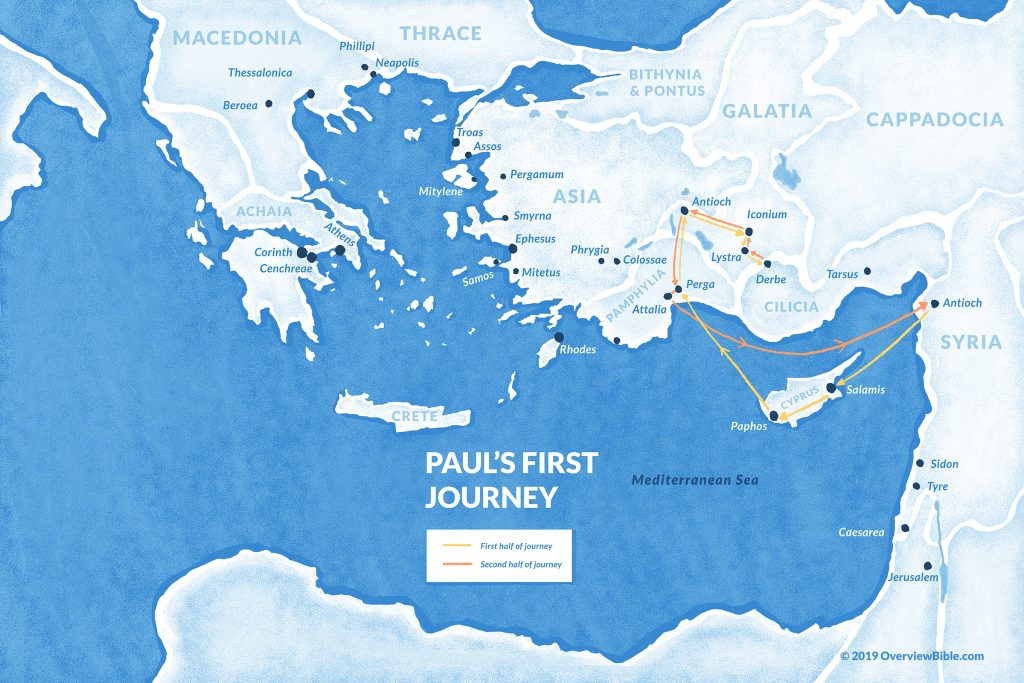
Paul’s first missionary journey began in Antioch. You may notice that maps of the ancient world often have two cities labelled Antioch. They’re both named after Antiochus, father of Seleucid I. The Antioch in Acts 13 was the third largest city in ancient Rome and capital of the province of Syria. Today, it’s part of southern Turkey. The other Antioch was part of Pisidia, an ancient region which is also now part of Turkey. Your Bible likely refers to it as Pisidian Antioch or Antioch of Pisidia.
In Antioch (the big city in Syria), the Holy Spirit singled out Paul and Barnabas from the believers worshiping there, and sent them on their first missionary journey.
Paul’s first journey took him by boat to the Roman province of Cyprus. Today, Cyprus is a country known as the Republic of Cyprus. It’s a mediterranean island south of Syria. Paul and Barnabas arrived in the port city of Salamis, where John Mark (who was possibly Barnabas’ cousin), helped them share the gospel in Jewish synagogues.
From Salamis, the group moved across the island to Paphos, where they were met by a Jewish sorcerer named Bar-Jesus (also known as Elymas the sorcerer). This sorcerer worked for the governor—Sergius Paulus—who sent for Paul and his companions because he wanted to hear the word of God. Elymas opposed them and tried to turn Sergius from the faith, and so Paul, filled with the Holy Spirit, called him a “child of the devil” and struck him blind. Sergius saw what happened, and believed.
Ironically, Elymas meant to steer Sergius away from Christ, but he became the very vehicle God used to draw Sergius toward him.
From Paphos, Paul and company set sail for the Roman province of Pamphylia, located in modern day Turkey. They arrived in the city of Perga, where John Mark left them and returned to Jerusalem (which, interestingly, was in the opposite direction from where they just came). We don’t know why John Mark decided to leave, but this would later create a rift between Paul and Barnabas.
Together, Paul and Barnabas travelled to Pisidian Antioch, where local synagogue leaders invited them to speak. Initially, the Jewish people were receptive to the gospel, but a week later, the entire city gathered to hear Paul and Barnabas, and the Jewish leaders became jealous. They resisted the message of the gospel, and so Paul and Barnabas made an important pivot: they began preaching to the Gentiles.
Many of the Gentiles believed the gospel, and Luke (the traditional author of Acts) tells us that:
“The word of the Lord spread through the whole region. But the Jewish leaders incited the God-fearing women of high standing and the leading men of the city. They stirred up persecution against Paul and Barnabas, and expelled them from their region.” —Acts 13:49–50
Driven out of Pamphylia, Paul and Barnabas travelled to Iconium, an eastern city in the region of Phrygia. Iconium still exists today as the Turkish city of Konya.
Once again, Paul and Barnabas spoke in the synagogue, where Jews and Greeks alike accepted the gospel. But the Jews who didn’t accept it stirred up trouble, even as Paul and Barnabas began performing signs and wonders (Acts 14:3). As support for Paul and Barnabas grew, so did the opposition they faced, and eventually, they became aware of a plot to abuse and stone them. So they left.
Fleeing the threat in Iconium, Paul and Barnabas left Phrygia altogether and travelled to Lystra, a city in the province of Lycaonia. Here, Paul healed a man who was lame.The locals who witnessed this miracle thought Paul and Barnabas were gods in human form, calling Barnabas Zeus and Paul Hermes. The priest from the temple of Zeus brought bulls and wreaths to offer sacrifices to them.
Paul and Barnabas attempted to redirect their praise to God, but struggled to keep the crowds from offering sacrifices to them.
Jews came from Antioch and Iconium and continued what they’d started. They riled up the crowds and convinced them to stone Paul. Believing he was dead, they dragged him outside the city. When the disciples gathered around him, Paul got up and went back inside the city.
Then Paul and Barnabas went to Derbe, another city in Lycaonia. There, they “won a large number of disciples” (Acts 14:21).
The return to Antioch
After a time in Derbes, Paul and Barnabas went back the way they came, working their way through Lystra, Iconium, Pisidian Antioch, and Perga. In each city, they encouraged the believers there and strengthened their faith, as they would continue doing on their future missionary journeys. They did, however, stop in a new Pamphylian city on the way: Attalia. Acts only mentions it in passing, but presumably, they established a community of believers there as well.
From there, they skipped a return voyage to the island of Cyprus and went straight back to Antioch (the big one), where they told the church what happened on their journey.
Paul’s second missionary journey (Acts 16:23–20:38)
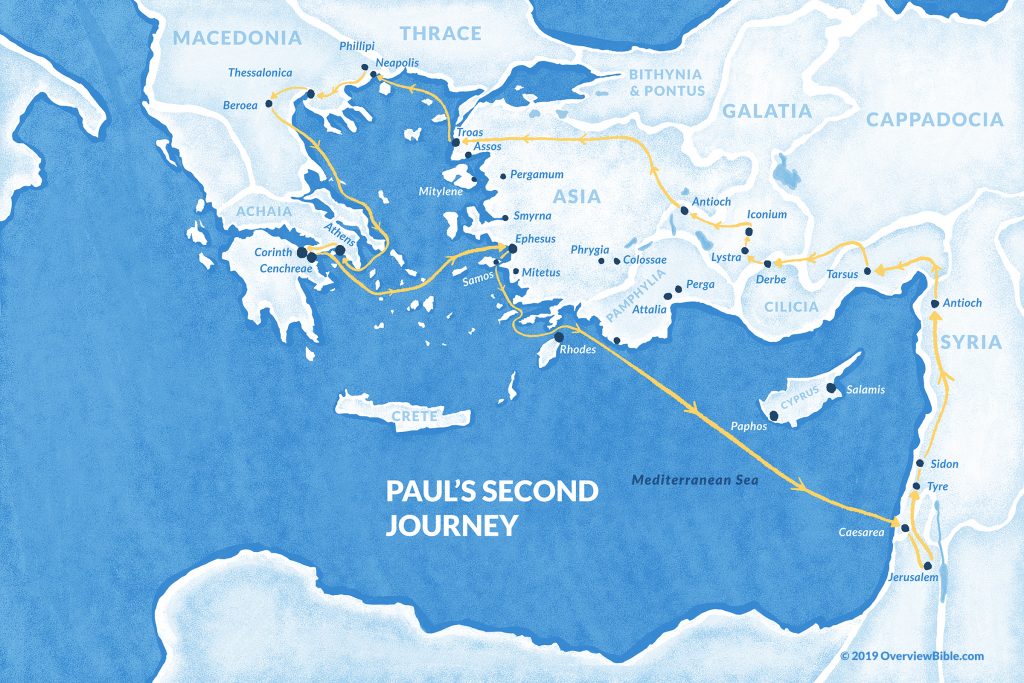
Paul’s second missionary journey established many of the churches he would later write to in his pastoral epistles. Interestingly, this may have happened in part because of a “sharp disagreement” he had with Barnabas. Paul’s original plan was to essentially have a rerun of their first trip, strengthening the communities they’d formed in each city and telling them what the Council of Jerusalem had ruled in regards to Gentile believers.
But Barnabas wanted to take John Mark—who had left them shortly into their previous journey. Paul was so opposed to the idea that they parted ways, initiating two separate missionary journeys. Barnabas took John Mark and went with the original plan, making their way back to the island of Cyprus. Paul took a man named Silas and travelled through the provinces of Syria and Cilicia.
The first cities that Acts mentions by name on Paul’s second journey are Derbe and Lystra. At this time, Paul and Silas picked up a new companion: Timothy.
The locals spoke highly of Timothy, and Paul wanted to bring him along even though he was half Greek, which meant local Jews would have a harder time accepting their message. Out of concern for these local Jews, Paul circumcised Timothy—even though, ironically, one of the things they were coming to tell Christians was that Gentiles didn’t have to be circumcised. (See Acts 16:3–4.)
Acts doesn’t specify where in Phrygia Paul and his companions stopped, but since he’d established a church in Iconium on the first trip, that community would’ve been on his mind (even though last time he was there, people had plotted to stone him). Interestingly, Acts notes that Paul and his companions journeyed here after they were “kept by the Holy Spirit from preaching the word in the province of Asia” (Acts 16:6).
Just north of Phrygia was the province of Galatia. Acts makes no mention of what happened here, but this is the province Paul wrote to in his letter to the Galatians . Interestingly, part of the purpose of Paul’s second trip was to share the news from the Council of Jerusalem regarding the Law of Moses and whether or not Gentiles (or Christians in general) should be expected to follow it. The council decided the Torah didn’t apply to Gentile believers (though they did hang on to a few rules). But by the time Paul wrote the Book of Galatians, Christians there were feeling pressure to obey the law (particularly in regards to circumcision) in order to be saved.
From Galatia, Paul’s group traveled west, until they reached the border of Mysia—a western region in the province of Asia, which is now part of Turkey. They intended to head north to the region of Bithynia, “but the spirit of Jesus would not allow them to” (Acts 16:7). So they passed by Mysia and headed to the city of Troas. Here, Paul had a vision of a man in Macedonia, begging him to “Come over to Macedonia and help us.” Paul took this vision as a sign that God was calling them to Macedonia, which was across the Aegean Sea.
From Troas, Paul and his companions sailed across the Aegean Sea, making a pitstop on the island of Samothrace before landing in Neapolis and then traveling to Philippi. In Philippi, they spoke with women outside the city gate. One of them was a wealthy cloth dealer named Lydia. After her household was baptised, she persuaded Paul’s group to stay with her for a while.
Later, Paul, Silas, and the others were confronted by a spirit-possessed slave woman who could predict the future. She followed them for many days, shouting, “These men are servants of the Most High God, who are telling you the way to be saved” (Acts 16:17). Paul became so annoyed that he cast out the spirit. Her owners were furious, because they had been profiting off of her fortune telling. So they turned the local magistrates against them, claiming Paul and Silas were stirring up trouble and trying to get Roman citizens to believe and do illegal things.
The authorities had Paul and Silas severely flogged and thrown in prison. Late at night, while they were worshiping, an earthquake shook the foundations of the prison, opened the doors, and freed the prisoners from their chains. When the jailer awoke and saw the doors open, he prepared to kill himself. But Paul stopped him and assured him everyone was still in the prison.
After listening to Paul and Silas share the gospel, the jailer believed in Jesus and had his whole household baptized.
The next morning, the magistrates ordered Paul and Silas released. Paul revealed that they were Roman citizens, who had just been beaten and imprisoned without trial, and the authorities became afraid. Paul and Silas returned to Lydia’s house, and then left the city of Troas.
After passing through the Macedonian cities of Amphipolis and Apollonia, they arrived in Thessalonica. Since Thessalonica had a synagogue, Paul turned to his usual method—preaching the gospel on the Sabbath. Over the course of three weeks, he achieved the usual result—many Jews and Greeks alike embraced the gospel . . . and those who didn’t were outraged by it.
At night, the Thessalonian believers sent Paul and his companions away to the nearby city of Berea.
The Bereans listened eagerly to the gospel and carefully examined the Scriptures to see if they supported Paul’s claims. Many Jews and Greeks became believers, but some agitators from Thessalonica heard Paul was in Berea, and they stirred up the crowds. Silas and Timothy stayed in Berea, while Paul was escorted out of Macedonia to Athens.
In the first century, Athens was in the region of Achaia, just south of Macedonia. Today, it’s the capital of Greece, and the largest city in the country.
Paul was essentially waiting around for Silas, Timothy, and the others to rejoin him. But while he waited, he noticed that Athens was full of idols. He debated with philosophers in both the synagogue and marketplace. Some Athenians were open to his ideas, and they were eager to discuss them. One idol in particular caught his eye—it had an inscription that read: “to an unknown god.” He seized on this as an opportunity to tell them about the “unknown God” who died and rose so that all might have eternal life.
Paul’s message in Athens incorporated observations about what he saw around him as well as quotes from famous Greek philosophers to point back to the gospel. After establishing a group of believers in Athens, Paul headed west to the city of Corinth.
In Corinth, Paul stayed and worked with a couple of Jewish tentmakers named Priscilla and Aquila. Every Sabbath, he preached to Jews and Greeks in the synagogue. Silas and Timothy rejoined Paul here, and Paul began focusing his energy on testifying about Jesus to the Jews.
When the Jews opposed his message, Paul devoted himself to reaching Gentiles, and he left the synagogue. As more Greeks embraced the gospel, the Corinthian Jews brought Paul before the governor, who basically told them to take a hike and refused to help.
Paul stayed in Corinth for a year and a half, and he left with Priscilla and Aquila.
The return journey
Before setting off for Syria, Paul stopped for a vow-fulfilling haircut in the port city of Cenchreae, which was just a hop, skip, and a jump from Corinth. With his companions, he sailed across the Aegean Sea to Ephesus, where he dropped of Priscilla and Aquila, and promised to come back if he could. After a short stay in Ephesus, Paul set sail for Caesarea, which was across the Mediterranean and far to the southeast. From there, he made the trek south to Jerusalem.
Paul’s second missionary journey ended in Jerusalem.
Paul’s third missionary journey (Acts 18:23–20:38)
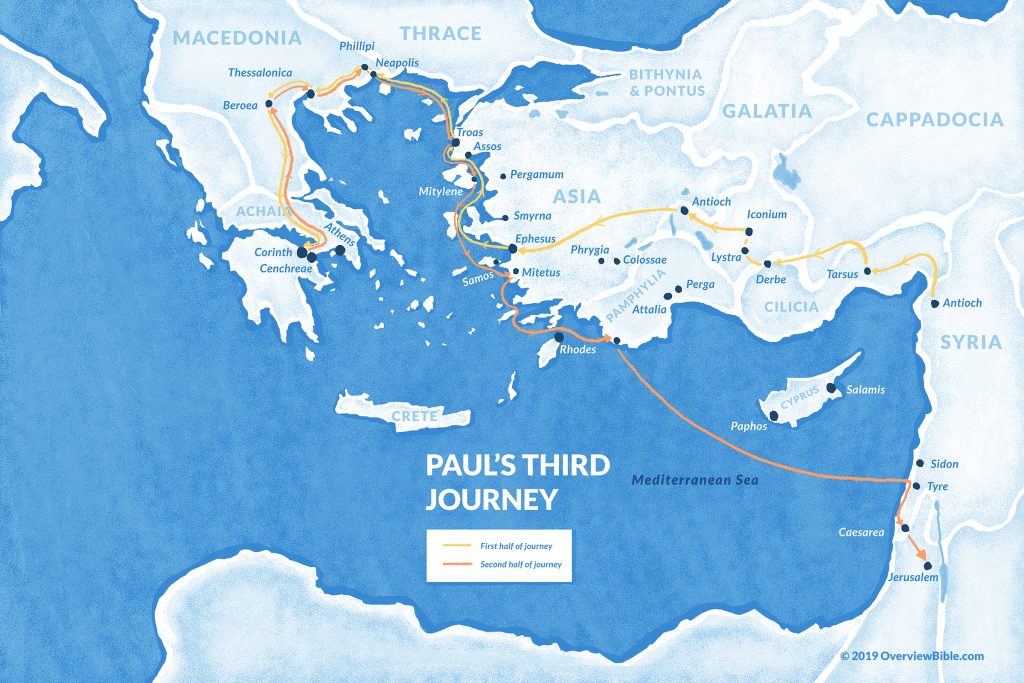
When you read Acts, there’s no transition from Paul’s second missionary journey to his third. His arrival in Jerusalem almost immediately began his next trip. But while his second journey ends in Jerusalem, the beginning of his third journey is actually in Antioch, which is about 300 miles north.
Phrygia and Galatia
From Antioch, Paul once again worked his way west, passing “from place to place throughout the region of Galatia and Phrygia, strengthening all the disciples” (Acts 18:23). This included Derbe, Lystra, and Iconium.
Paul traveled west to Ephesus, the capital of the province of Asia, where he’d left Priscilla and Aquila on his previous journey. Since he’d last visited, a man named Apollos had been preaching part of the gospel, but he didn’t know about the Holy Spirit. So when Paul arrived, he taught the Ephesians about the difference between water baptism and the baptism of the Spirit.
For three months, Paul preached in the synagogues. When people started criticizing Christianity, he left and began holding discussions in a lecture hall.
This went on for two years, and all the while, God used Paul to perform miracles. Even things Paul had touched—handkerchiefs and aprons—healed the sick and drove out evil spirits.
Some Jews thought invoking Paul’s name would let them drive out demons. Seven sons of a chief priest named Sceva said to an evil spirit, “In the name of the Jesus whom Paul preaches, I command you to come out” (Acts 19:13). The spirit replied that it knew Jesus and Paul, but not them, and then it pulverized all seven of them.
As word spread about what happened, people began to revere the name of Jesus. Local sorcerors came to repent, and they burnt scrolls that would have been worth more than 130 years’ worth of wages (Acts 19:19).
Around this time, a local silversmith named Demetrius realized that the future of his business (making idols) was jeopardized by the gospel. The demand for idols was going down all across the province of Asia, but especially in Ephesus, where he lived. So Demetrius gathered all the craftsmen and workers whose businesses were impacted, and stirred the entire city into an uproar. They seized two of Paul’s companions and brought them into a theater.
Paul wanted to address the crowd, but the disciples didn’t let him. Instead, a city clerk told everyone that unless they were going to bring formal charges against the men in a legal assembly, they were in danger of being charged with rioting.
Macedonia and Greece
After things settled down in Ephesus, Paul headed across the Aegean Sea to Macedonia. He traveled throughout the region, encouraging believers, and eventually arrived in Greece, where he stayed for three months. He intended to sail back to Syria (where his journey started), but some people plotted against him, so he took another lap through Macedonia instead.
Along the way, disciples joined Paul from many of the communities he’d ministered to. He had companions from Berea, Thessalonica, Derbe, and the province of Asia. These followers went ahead of Paul to Troas, in Asia. Paul stayed briefly in Philippi, then joined them.
Paul stayed in Troas for seven days. The night before he left, he stayed up late talking in a room upstairs. A young man sat in a window, drifted off to sleep, and fell to his death. Paul threw his arms around the man and declared that he was alive, and he was. Then Paul went back upstairs and continued talking until daylight.
Paul walked from Troas to Assos, which was just to the south, and then sailed for the nearby city of Mitylene. Eager to reach Jerusalem before Pentecost, Paul sailed past Ephesus and stopped in Miletus. There, he met with the leaders of the Ephesian church and essentially told them that he had taught them everything they needed to know, that he would not see them again, and that they needed to be on guard against false teachers. This is when Paul also famously quoted Jesus, sharing words that aren’t recorded in any of the gospels: “It is more blessed to give than to receive” (Acts 20:35).
And then he set sail.
Paul and his companions stopped briefly in Kos, Rhodes, and Patara before heading across the Mediterranean Sea to Phoenicia (the coastal region south of ancient Syria, which is now part of Syria). They arrived in Tyre, where “through the Spirit” (Acts 21:4), the local disciples urged Paul not to go to Jerusalem. He ignored them.
From Tyre, the voyage continued to the port city of Ptolemais, and then Caesarea, where the group stayed with Philip the evangelist (not to be confused with Philip the apostle ). Here, a prophet warned Paul that he would be bound by the Jews in Jerusalem and handed over to the Gentiles.
Still, he pressed on to Jerusalem, and by the end of Acts, the Jewish leaders had handed him over to Roman rulers.
Paul’s fourth missionary journey
Acts explicitly records three distinct missionary journeys. But some scholars and even ancient Christian writers have claimed that there was also a fourth missionary journey which was only hinted at in the Bible.
The argument for a fourth journey is primarily based on clues from Paul’s letters. He occasionally refers to events and visits that may not be accounted for in Acts or the epistles.
For example, Paul suggested he would travel to Spain (Romans 15:24), but he provides no record of this journey in his letters. However, early church fathers claimed Paul did, in fact, travel to Spain.
In his letter to the Corinthians, first-century church father Clement of Rome said Paul “had gone to the extremity of the west,” which at the time presumably meant Spain. Fourth-century church father John of Chrysostom said, “For after he had been in Rome, he returned to Spain, but whether he came thence again into these parts, we know not.” And Cyril of Jerusalem (also from the fourth century) wrote that Paul “carried the earnestness of his preaching as far as Spain.”
In 2 Timothy 4, Paul makes an ambiguous reference to “my first defense” and claims he was “delivered from the lion’s mouth” (2 Timothy 4:16-17). Some have interpreted this as a reference to his first defense before Emperor Nero, which he was heading for at the end of Acts.
Paul’s letters make other references to events not recorded in Acts, but since there is so much overlap in the locations mentioned, and Paul spent multiple years in some of these places on his three recorded journeys, it’s difficult to say whether or not this fourth journey ever actually happened.
Take a closer look at Paul’s footsteps
Paul’s missionary journeys are a key part of the New Testament. Paul’s epistles were originally written to the communities he formed on these journeys, and they show us exactly how Christianity spread to the Gentiles so rapidly.
Here at OverviewBible, we’ve charted each of Paul’s missionary journeys into beautiful, full-color posters you can display in your classroom or church office. Each comes in multiple sizes on fine art paper with a matte finish.

Get an overview of the entire Bible
The Bible is huge. Together, its 66 books are three times longer than Moby Dick . It’s so big that even if you’ve been reading it your whole life, you can still miss the point. Jeffrey Kranz, founder of OverviewBible, wrote The Beginner’s Guide to the Bible to help Christians and non-Christians alike get a better grasp of this important text.
This non-preachy, jargon-free guide will walk you through the Bible’s major themes and characters and help you see how each book fits into the larger story of Scripture.
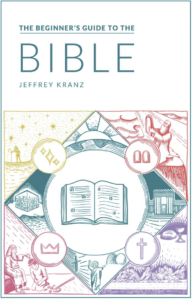
Explore the Bible with us!
We create research-based articles and handy infographics to help people understand the Bible.
Join our email list, and we’ll send you some of our best free resources—plus we’ll tell you whenever we make something new.
You have Successfully Subscribed!

- Bible Books
- Bible characters
- Bible facts
- Bible materials
- Bible topics
Recent Posts
- Interesting Facts about the Bible
- Logos Bible Software 10 review: Do you REALLY need it?
- Who Was Herod? Wait… There Were How Many Herods?!
- 16 Facts About King David
- Moses: The Old Testament’s Greatest Prophet
Privacy Overview
Paul the Evangelist traveled 10,000 miles to preach Christianity
By Ray Konig | azbible.com
About 2000 years ago, a man named Saul traveled to Damascus with the plan of rounding up Christians and taking them as prisoners to Jerusalem, so they could be persecuted for their beliefs.
He detested Christians. As he got closer to Damascus, which is a journey of about 150 miles from Jerusalem, he was engulfed in blinding light and encountered the resurrected Jesus.
The light blinded Saul and remained unable to see for three days. He converted to Christianity and became its best-known evangelist. His name was changed to Paul and he since has been known and referred to as Paul the Apostle and Paul the Evangelist.
Paul's encounter with the resurrected Jesus transformed his life. He went from trying to bring an end to Christianity to traveling roughly 10,000 miles throughout western Asia and parts of Europe to preach about Jesus and Christianity.
And he did so at risk to himself, as Christianity was not a legal religion within the Roman Empire at that time.
Below are descriptions and maps of each of the four evangelical journeys that Paul undertook during his life, after becoming a Christian. These journeys, and other details of Paul's life, are described in the Book of Acts, which is in the New Testament of the Christian Bible.
Paul's first journey
- Paul's second journey
- Paul's third journey
- Paul's journey to Rome
From about 46 AD to 48 AD (more than 1900 years ago), Paul the evangelist undertook his first mission journey. He traveled from Syrian Antioch to Derbe, and back again. This journey is described in the Bible's book of Acts, chapters 13 and 14. Click on any of the map markers and more information about that place will pop up.
The places that Paul visited during his first missionary journey are listed below in chronological order.
Saul (Paul) begins his first mission journey. He and Barnabas eventually travel hundreds of miles from Antioch to Derbe, and then back again. The first part of their journey takes them to Seleucia. Acts 13:1-4. (View on map)
From Antioch, Paul and Barnabas go to Seleucia, where they sail to Salamis in Cyprus. Seleucia, also known as Seleucia Pieria, now falls within the modern boundaries of Turkey, near Syria. Acts 13:4-5. (View on map)
In Salamis, Paul and Barnabas preach the word of God in Jewish synagogues. (There were many Jewish communities scattered throughout the Roman Empire). They then travel across the island to Paphos. Acts 13:4-7. (View on map)
In Paphos, Paul and Barnabas are sought out by a community leader named Sergius Paulus. A false prophet unsuccessfully tries to prevent Paul and Barnabas from evangelizing. The false prophet becomes blind during his confrontation. Acts 13:6-12. (View on map)
From Paphos, Paul and Barnabas sail to Perga on their way to Pisidian Antioch. Acts 13:13. (View on map)
Pisidian Antioch
In Pisidian Antioch, Paul tells people in a synagogue that Jesus Christ is the Messiah who was promised in the Old Testament . Many people turn against Paul and Barnabas. They leave for Iconium. Acts 13:14-52. (View on map)
In Iconium, Paul and Barnabas are met with great resistance to the Gospel. They learn that there is a plot to have them killed. They flee to the nearby towns of Lystra and Derbe. Acts 14:1-7. (View on map)
In Lystra, a man who had never been able to walk is miraculously healed through Paul. The town's people proclaim that Paul and Barnabas are gods. Paul and Barnabas correct them. Paul is later stoned, dragged out of the city, and left for dead. He recovers and travels to Derbe. Acts 14:8-20. (View on map)
Through the preaching of Paul and Barnabas, many people in Derbe learn about Jesus and become disciples. Paul and Barnabas later return to Lystra. Acts 14:20-21. (View on map)
After returning to Lystra, Paul and Barnabas meet with the new disciples, encouraging them to remain true to the faith. Acts 14:21-22. (View on map)
Paul and Barnabas return to Iconium to strengthen the new disciples there. Acts 14:21-22. (View on map)
Paul and Barnabas return to Pisidian Antioch to encourage and strengthen the new disciples there. Acts 14:21-22. (View on map)
Paul and Barnabas preach the Gospel in Perga before heading to Attalia. Acts 14:24-25. (View on map)
In Attalia, Paul and Barnabas sail back to the Syrian Antioch, the city from which they had begun this mission journey. Acts 14:26. (View on map)
In Antioch, Paul and Barnabas meet with fellow Christians and give a report about their mission journey. Paul and Barnabas stay in Antioch for a while, spending time with disciples. Acts 14:27-28. (View on map)
Map of Paul's second mission journey
Paul's second missionary journey took place between 49 AD and 52 AD, more than 1900 years ago. He traveled through part of Asia and Europe. This journey is described in the Bible's book of Acts, chapters 15, 16, 17 and 18. Click on any of the map markers and more information about that place will pop up.
The places that Paul visited during his second missionary journey are listed below in chronological order.
Paul begins his second mission journey. Paul, Barnabas, Silas, and other evangelists, first travel from Jerusalem to Antioch. Acts 15:22. (View on map)
Paul and Barnabas have a disagreement. They part ways. Barnabas goes to Cyprus. Paul and Silas travel through Syria and Cilicia. Acts 15:36-41. (View on map)
Paul travels through Cilicia, which includes the city of Tarsus. Acts 15:36-41. (View on map)
Paul travels to the towns of Derbe and Lystra, both of which he had visited during his first mission journey. Acts 16:1-5. (View on map)
In Lystra, Paul meets Timothy, who becomes an evangelist. Acts 16:1-5. (View on map)
It is possible that Paul travels through Iconium, on his way to Troas, given the information in Acts 16:1-6. (View on map)
It is possible that Paul travels through Pisidian Antioch, on his way to Troas, given the information in Acts 16:1-6. (View on map)
After arriving in Troas, Paul has a vision telling him to go to Macedonia and evangelize there. Acts 16:6-10. (View on map)
Paul and Silas sail from Troas to Neapolis, en route to Philippi, a city in Macedonia. Acts 16:11-12. (View on map)
Paul evangelizes to Lydia, a successful businesswoman. "The Lord opened her heart to respond to Paul's message." - Acts 16:14. Lydia becomes the first known Christian in Europe. Her family converts, too. Paul and Silas are wrongly imprisoned. An earthquake destroys the prison. Paul and Silas comfort the jailer. The jailer and his family become Christians. Acts 16:16-40. (View on map)
After being released from prison, Paul and Silas pass through Amphipolis and Apollonia on their way to Thesalonica, which has a Jewish community. Acts 17:1. (View on map)
Thessalonica
In Thessalonica, Paul preaches in a Synagogue. Some Jews and Greeks are brought to faith. Later, a mob tries, unsuccessfully, to capture Paul and Silas. Acts 17:2-9. (View on map)
In Berea, Paul again preaches in a Synagogue. Many Jews and Greeks convert to Christianity. Others, angered by Paul, seek to harm him. Paul's associates send Paul out of town to protect him. He goes to Athens. Acts 17:10-15. (View on map)
In Athens, Paul is distressed by the extent of idol worship. He preaches about Jesus and the resurrection. Some oppose him. Others become believers, including a man named Dionysius and a woman named Damaris. Acts 17:16-34. (View on map)
From Athens, Pauls travels to Corinth and evangelizes. He meets a Jew named Aquila and his wife Priscilla, who moved to Corinth after Roman Emperor Claudius ordered Jews to leave Rome. Acts 18:1-4. (View on map)
Paul leaves Corinth, with Aquila and Priscilla, ang goes to Cenchrea (or Cenchrae) and has his hair cut off. He does this to fulfill a vow, but we are not told what that vow was. He later sails to Ephesus. Acts 18:18. (View on map)
Paul, Priscilla and Aquila, sail to Ephesus. Paul evangelizes at a synagogue. Paul leaves for Caesarea. Priscilla and Aquila stay behind in Ephesus. Acts 18:19-21. (View on map)
From Caesarea, Paul travels to Jerusalem, which is inferred from verse 22, before traveling to Antioch, from where he later would begin his third mission journey. Acts 18:22. (View on map)
Map of Paul's third mission journey
Paul's 3rd missionary journey took place between 54 AD and 58 AD, more than 1900 years ago. He traveled through parts of Asia and Europe. This journey is described in the Bible's book of Acts 18:23-28; Acts 19; Acts 20; through Acts 21:17. Click on any of the map markers and more information about that place will pop up.
The places that Paul visited during his third missionary journey are listed below in chronological order.
Paul begins his third mission journey. "After spending some time in Antioch, Paul set out from there and traveled from place to place throughout the region of Galatia and Phrygia, strengthening all the disciples." - NIV English translation of Acts 18:23. (View on map)
Paul travels from Antioch to Ephesus. Tarsus is on the way, and based on Acts 18:23, Paul might have re-visited disciples there. (View on map)
Paul travels from Antioch to Ephesus. Iconiumn is on the way, and based on Acts 18:23, he might have re-visited disciples there. (View on map)
In Ephesus, God performs miracles of healing through Paul; many people are brought to faith. Later, idol makers who worship the goddess Artemis encourage a riot in rebellion to Paul's faithful teachings about Jesus. Acts 19:1-41. (View on map)
After the uproar in Ephesus ends, Paul travels through the countries of Macedonia and Greece. He might have re-visited communities that he had previously traveled to or through as an evangelist, such as Troas. Acts 20:1-6. (View on map)
Paul travels through the countries of Macedonia and Greece. He might have re-visited communities that he had previously traveled to or through as an evangelist, such as Neapolis. Acts 20:1-6. (View on map)
Paul travels through the countries of Macedonia and Greece. He might have re-visited communities that he had previously traveled to or through as an evangelist, such as Philippi. Acts 20:1-6. (View on map)
Paul travels through the countries of Macedonia and Greece. He might have re-visited communities that he had previously traveled to or through, such as Amphipolis. Acts 20:1-6. (View on map)
Paul travels through the countries of Macedonia and Greece. He might have re-visited communities that he had previously traveled to or through, such as Apollonia. Acts 20:1-6. (View on map)
Paul travels through the countries of Macedonia and Greece. He might have re-visited communities that he had previously traveled to or through, such as Thessalonica. Acts 20:1-6. (View on map)
Paul travels through the countries of Macedonia and Greece. He might have re-visited communities that he had previously traveled to or through, such as Berea. Acts 20:1-6. (View on map)
Paul travels through the countries of Macedonia and Greece. He might have re-visited communities that he had previously traveled to or through, such as Athens. Acts 20:1-6. (View on map)
Paul travels through the countries of Macedonia and Greece. He might have re-visited communities that he had previously traveled to or through, such as Corinth. Acts 20:1-6. (View on map)
After traveling through Macedonia and Greece, Paul goes to Philippi before sailing to Troas. Acts20:6. (View on map)
Acts 20:6 informs us that Paul travels from Philippi to Troas. After leaving Philippi, it is possible that he set sail from a port in Neapolis, just south of Philippi, en route to Troas. Neapolis today is called Kavalla. Acts 20:6. (View on map)
Paul delivers a lengthy sermon in the upper chamber of a building. A young man named Eutychus was sitting on a window sill listening to Paul. Eutychus falls asleep and tumbles out of the third-floor window to his death on the ground below. Paul heals the man, bringing him back to life. Acts 20:7-12. (View on map)
Paul leaves Troas and travels by foot to Assos. Acts 20:13. (View on map)
From Assos, Paul and others sail to Mitylene. Acts 20:14. (View on map)
The day after arriving in Milylene, Paul and others set sail to Kios (Chios). Acts 20:15. (View on map)
In Miletus, Paul meets with church elders from Ephesus. He tells them, "I consider my life worth nothing to me, if only I may finish the race and complete the task the Lord Jesus has given me—the task of testifying to the gospel of God's grace." (Acts 20:24). Acts 20:15-24. (View on map)
From Miletus, Paul sails to Cos. Acts 21:1. (View on map)
From Cos, Paul sails to Rhodes. Acts 21:1. (View on map)
From Rhodes, Paul sails to Patara. Acts 21:1. (View on map)
From Patara, Paul and his companions find a ship that is sailing for Tyre. They pass by Cyprus, sailing south of the island, and stop at Tyre. They meet with disciples and stay with them for seven days. Acts 21:2-6. (View on map)
Paul and others continue their voyage, sailing from Tyre to Ptolemais, staying there for a day to meet with disciples. Acts 21:7 (View on map)
Paul travels to Caesarea. A prophet named Agabus tells Paul that Paul will be bound and handed over to the Gentiles if he returns to Jerusalem. Paul responds, "I am ready not only to be bound, but also to die in Jerusalem for the name of the Lord Jesus." Acts 21:8-16. (View on map)
Paul arrives in Jerusalem. A riot is started by people who claim that Paul has defiled Judaism with his teachings about Christianity. Paul is bound and arrested by Roman soldiers. Acts 21:17-40 and all of Acts 22. Paul eventually is taken to Rome, as a prisoner . (View on map)
Map of Paul's journey to Rome
Around 59 A.D. and 60 A.D., Paul the evangelist was taken as a prisoner from Caeserea to Rome, making several stops along the way. Even as a prisoner, he continued to evangelize. This journey is described in the Bible's book of Acts, chapters 26, 27 and 28. Click on any of the map markers and more information about that place will pop up.
The places that Paul visited during his journey to Rome are listed below in chronological order.
In Jerusalem, Paul evangelizes about Jesus. This angers a group of non-believers who retaliate by starting a riot. Paul is arrested. (Acts 21:17-40; Acts 22.) He is taken to Caesarea and questioned. (Acts, chapters 23-26.) It is decided that Paul is to be taken to Rome, as a prisoner. Acts 27:1-2. (View on map)
Paul is taken as a Roman prisoner from Caesarea to Sidon, on his way to Rome. In Sidon, Paul is permitted to visit friends who reside there. Acts 27:3. (View on map)
From Sidon, Paul is taken by ship to Myra. There, Paul and other prisoners are taken to an Alexandrian ship, which is heading for Italy. Acts 27:5. (View on map)
From Myra, Paul and the other prisoners sail for Cnidus, arriving there after several days. Acts 27:7. (View on map)
Fair Havens
From Cnidus, Paul's ship has a slow and difficult journey to Fair Havens. Acts 27:8. (View on map)
The ship sails from Fair Havens. A violent storm batters the ship. Paul is told by an angel of God that everyone will survive. After two weeks, the ship is shattered against the rocks near Malta. Everyone on board makes it to shore, safely. Acts 27:8-44. (View on map)
After three months in Malta (also known as Melita), Paul and the others are taken to another ship heading to Rome. The ship stops at a handful of ports along the way, including Syracuse. Acts 28:11-12. (View on map)
After three days in Syracuse, the ship sails for Rhegium, on the way to Rome. Acts 28:12-13. (View on map)
From Rhegium, Paul is taken to Puteoli, where Paul is permitted to visit friends. Acts 28:13-14. (View on map)
Paul is taken from Puteoli to Rome. In Rome, he is permitted to live in a rented home, under the watch of a Roman guard. The book of Acts comes to a close, informing us that Paul remains in Rome for two years, evangelizing about Jesus Christ. Acts 28:16-31. (View on map)
© Ray Konig | azbible.com
Next article: Animation of the spread of Christianity in the book of Acts
©azbible.com | Back to top | Home
- Log In Sign Up
- Read the Bible
- Bible Versions
- Verse of the Day
- Reading Plans
- Verses by Topic
- Books of the Bible
- Bible Images
- Commentaries
- Concordances
- Dictionaries
- Encyclopedias
- Bible Atlas & Maps
- Devotionals
- Today's Devotionals
- Light of the World
- All Devotionals
- Inspirational Quotes
- Picture Quotes
- Inspirational
- Bible Study
- What The Bible Says
- Bible Q&As
- Daily Bread
- Bible by Genre
- Bible Stories
- Random Bible Verse
Paul's Last Journeys
Be the first to react on this!
Get Bible verse every day in your inbox
Read on Mobile
Group of Brands

- Statement of Faith
- Privacy Policy
- Terms and Conditions
- Permissions Policy
- BP ScriptureTagger
- VotD RSS Feeds
- Article RSS Feeds
6200 2nd St NW Washington, DC 20011
Paul’s Missionary Journeys: A Map-Based Study of His Travels

The Apostle Paul is one of the most important figures in the New Testament, and his missionary journeys played a key role in spreading Christianity throughout the Mediterranean world. By exploring these journeys through maps and geography, we can gain a deeper understanding of Paul's travels and the impact they had on the early Christian church.
Paul's first missionary journey began in the city of Antioch, in modern-day Turkey. From there, he traveled to Cyprus and then on to cities in modern-day Turkey, including Iconium, Lystra, and Derbe. Paul faced many challenges during this journey, including opposition from local Jews and persecution from Roman authorities. Despite these challenges, Paul's preaching was successful in converting many people to Christianity.
Paul's second missionary journey took him to Greece, where he traveled to cities like Athens and Corinth. He also returned to some of the cities he visited on his first journey, such as Philippi and Thessalonica. During this journey, Paul faced many challenges, including opposition from local authorities and a split with his fellow missionary, Barnabas.
Paul's third missionary journey was focused on strengthening the churches he had previously established. He traveled to cities in modern-day Turkey, Greece, and Macedonia, including Ephesus, Thessalonica, and Corinth. During this journey, Paul continued to face opposition and persecution, but his preaching was successful in converting many people to Christianity.
In addition to these three journeys, Paul also traveled to Rome as a prisoner, where he was eventually executed for his beliefs. By exploring Paul's journeys through maps and geography, we can gain a deeper understanding of the challenges he faced and the impact his preaching had on the early Christian church.
Through mapping and exploring Paul's journeys, we can gain a better understanding of the history and culture of the Mediterranean world during the first century AD. We can also gain a deeper appreciation for the impact that Paul's preaching had on the early Christian church, and the lasting legacy of his work. Whether we are religious or not, studying Paul's journeys through maps is a fascinating way to learn about the early history of Christianity and the world in which it developed.
Related Posts
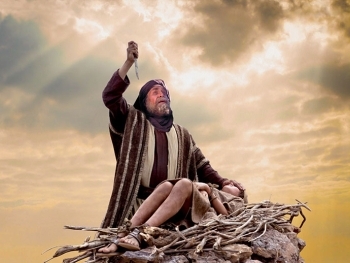
Abraham’s Obedience: Lessons in Trusting God
Abraham, often referred to as the "father of faith," is a key figure in the biblical narrative renowned for his... Read More

Understanding Moses’ Relationship with God Through Prayer
Moses, a central figure in the biblical narrative, is known for his close and intimate relationship with God. This connection... Read More
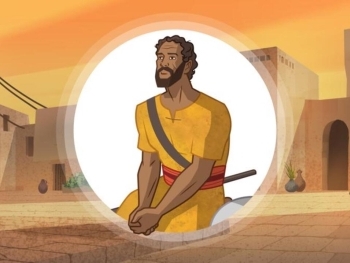
Crossing the Jordan: Joshua’s First Miraculous Act
The crossing of the Jordan River under the leadership of Joshua is a pivotal and miraculous event recounted in the... Read More
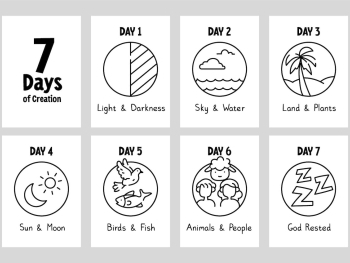
Theological Reflections: God’s Creative Process in Genesis
The opening chapters of the Book of Genesis provide a foundational narrative for understanding the Judeo-Christian concept of creation. The... Read More
Account Options
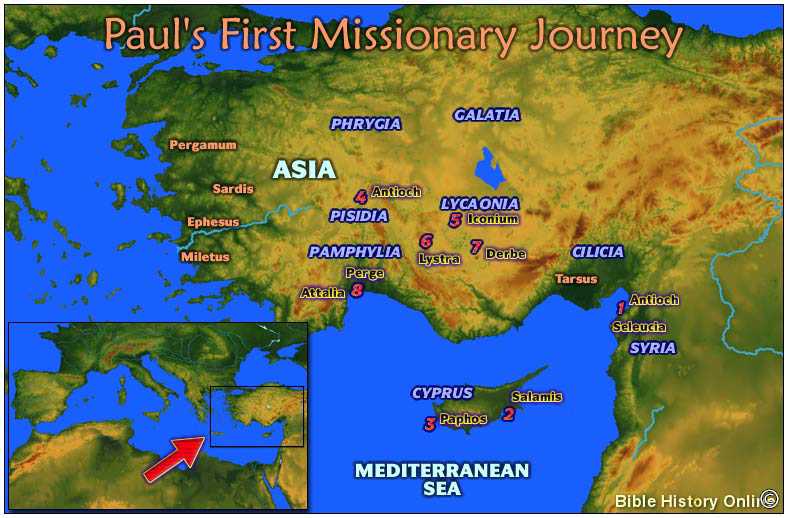
The Boundaries of the Roman Empire were: North : The British Channel, the Rhine, the Danube, and the Black Sea South : The deserts of Africa, the cataracts of the Nile, & the Arabian deserts East : The Euphrates West : The Atlantic
Romans 1:7 - To all that be in Rome , beloved of God, called [to be] saints: Grace to you and peace from God our Father, and the Lord Jesus Christ.
Paul in the Smith's Bible Dictionary
Paul (small, little). Nearly all the original materials for the life St. Paul are contained in the Acts of the Apostles and in the Pauline epistles. Paul was born in Tarsus, a city of Cilicia. (It is not improbable that he was born between A.D. 0 and A.D. 5.) Up to the time of his going forth as an avowed preacher of Christ to the Gentiles, the apostle was known by the name of Saul. This was the Jewish name which he received from his Jewish parents. But though a Hebrew of the Hebrews, he was born in a Gentile city. Of his parents we know nothing, except that his father was of the tribe of Benjamin, Phm 3:5 and a Pharisee, Ac 23:6 that Paul had acquired by some means the Roman franchise ("I was free born,") Ac 22:23 and that he was settled in Tarsus. At Tarsus he must have learned to use the Greek language with freedom and mastery in both speaking and writing. At Tarsus also he learned that trade of "tent-maker," Ac 18:3 at which he afterward occasionally wrought with his own hands. There was a goat's-hair cloth called cilicium manufactured in Cilicia, and largely used for tents, Saul's trade was probably that of making tents of this hair cloth. When St. Paul makes his defence before his countrymen at Jerusalem, Ac 22:1 ... he tells them that, though born in Tarsus he had been "brought up" in Jerusalem. He must therefore, have been yet a boy when was removed, in all probability for the sake of his education, to the holy city of his fathers. He learned, he says, at the feet of Gamaliel." He who was to resist so stoutly the usurpations of the law had for his teacher one of the most eminent of all the doctors of the law. Saul was yet "a young man," Ac 7:58 when the Church experienced that sudden expansion which was connected with the ordaining of the seven appointed to serve tables, and with the special power and inspiration of Stephen. Among those who disputed with Stephen were some "of them of Cilicia." We naturally think of Saul as having been one of these, when we find him afterward keeping the clothes of those suborned witnesses who, according to the law, De 17:7 were the first to cast stones at Stephen. "Saul," says the sacred writer significantly "was consenting unto his death." Full Article
Paul in the Bible Encyclopedia - ISBE 5. The First Great Mission Campaign: Acts 13 and 14, 47 and 48 AD: Paul had already preached to the Gentiles in Cilicia and Syria for some 10 years. The work was not new to him. He had had his specific call from Jerusalem long ago and had answered it. But now an entirely new situation arises. His work had been individual in Cilicia. Now the Spirit specifically directs the separation of Barnabas and Saul to this work (Acts 13:2). They were to go together, and they had the sympathy and prayers of a great church. The endorsement was probably not "ordination" in the technical sense, but a farewell service of blessing and good will as the missionaries went forth on the world-campaign (Acts 13:3). No such unanimous endorsement could have been obtained in Jerusalem to this great enterprise. It was momentous in its possibilities for Christianity. Hitherto work among the Gentiles had been sporadic and incidental. Now a determined effort was to be made to evangelize a large section of the Roman empire. There is no suggestion that the church at Antioch provided funds for this or for the two later Campaigns, as the church at Philippi came to do. How that was managed this time we do not know. Some individuals may have helped. Paul had his trade to fall back on, and often had resort to it later. The presence of John Mark "as their attendant" (Acts 13:5) was probably due to Barnabas, his cousin (Col 4:10). The visit to Cyprus, the home of Barnabas, was natural. There were already some Christians there (Acts 11:20), and it was near. They preach first in the synagogues of the Jews at Salamis (Acts 13:5). We are left to conjecture as to results there and through the whole island till Paphos is reached. There they meet a man of great prominence and intelligence, Sergius Paulus, the Roman proconsul, who had been under the spell of a sorcerer with a Jewish name--Elymas Bar-jesus (compare Peter's encounter with Simon Magus in Samaria). In order to win and hold Sergius Paulus, who had become interested in Christianity, Paul has to punish Bar-jesus with blindness (Acts 13:10 ff) in the exercise of that apostolic power which he afterward claimed with such vigor (1 Cor 5:4 f; 2 Cor 13:10). He won Sergius Paulus, and this gave him cheer for his work. From now on it is Paul, not Saul, in the record of Luke, perhaps because of this incident, though both names probably belonged to him from the first. Now also Paul steps to the fore ahead of Barnabas, and it is "Paul's company" (Acts 13:13) that sets sail from Paphos for Pamphylia. There is no evidence here of resentment on the part of Barnabas at the leadership of Paul. The whole campaign may have been planned from the start by the Holy Spirit as the course now taken may have been due to Paul's leadership. John Mark deserts at Perga and returns to Jerusalem (his home), not to Antioch (Acts 13:13). Paul and Barnabas push on to the tablelands of Pisidia. Ramsay (St. Paul the Traveler, 93) thinks that Paul had malaria down at Perga and hence desired to get up into higher land. That is possible. The places mentioned in the rest of the tour are Antioch in Pisidia (Acts 13:14), and Iconium (Acts 13:51), Lystra (Acts 14:8), and Derbe (Acts 14:20), cities of Lycaonia. These terms are ethnographic descriptions of the southern divisions of the Roman province of Galatia, the northern portion being Galatia proper or North Galatia. So then Paul and Barnabas are now at work in South Galatia, though Luke does not mention that name, using here only the popular designations. The work is wonderfully successful. In these cities, on one of the great Roman roads east and west, Paul is reaching the centers of provincial life as will be his custom. At Antioch Paul is invited to repeat his sermon on the next Sabbath (Acts 13:42), and Luke records at length the report of this discourse which has the characteristic notes of Paul's gospel as we see it in his epistles. Paul may have kept notes of the discourse. There were devout Gentiles at these services. These were the first to be won, and thus a wider circle of Gentiles could be reached. Paul and Barnabas were too successful at Antioch in Pisidia. The jealous Jews opposed, and Paul and Barnabas dramatically turned to the Gentiles (Acts 13:45 ff). But the Jews reached the city magistrate through the influential women, and Paul and Barnabas were ordered to leave (Acts 13:50 f). Similar success brings like results in Iconium. At Lystra, before the hostile Jews come, Paul and Barnabas have great success and, because of the healing of the impotent man, are taken as Mercury and Jupiter respectively, and worship is offered them. Paul's address in refusal is a fine plea on the grounds of natural theology (Acts 14:15-18). The attempt on Paul's life after the Jews came seemed successful. In the band of disciples that "stood round about him," there may have been Timothy, Paul's son in the gospel. From Derbe they retrace their steps to Perga, in order to strengthen the churches with officers, and then sail for Seleucia and Antioch. They make their report to the church at Antioch. It is a wonderful story. The door of faith is now wide open for the Gentiles who have entered in great numbers (Acts 14:27). No report was sent to Jerusalem. What will the Pharisaic party do now? Full Article including Paul's Second and Third Campaigns
The Bible Mentions "Paul" in many places:
You are using an outdated browser. Upgrade your browser today or install Google Chrome Frame to better experience this site.
- Bible Studies
- New/Special
- Encouragement
- Christian Symbols
- Scholarly Articles
- Way of the Cross
- Thanksgiving
- St. Patrick's Day
- New Year's Day
- Steps to Peace with God
- Articles/Stories
Beginning the Journey (for new Christians) . en Español
Old Testament Abraham Jacob Moses Joshua Gideon David, Life of Elijah Psalms Songs of Ascent (Ps 120-135) Isaiah Advent/Messianic Scriptures Daniel Rebuild & Renew: Post-Exilic Books
Gospels Christmas Incarnation (Mt, Lk) Sermon on the Mount (Mt 5-7) Mark Luke's Gospel John's Gospel 7 Last Words of Christ Parables Jesus and the Kingdom Resurrection
Acts The Early Church (Acts 1-12) Apostle Paul (Acts 12-28)
Paul's Epistles Christ Powered Life (Rom 5-8) 1 Corinthians 2 Corinthians Galatians Ephesians Vision for Church (Eph) Philippians Colossians, Philemon 1 & 2 Thessalonians 1 & 2 Timothy, Titus
General Epistles Hebrews James 1 Peter 2 Peter, Jude 1, 2, and 3 John
Revelation Revelation Conquering Lamb of Revelation
Topical Glorious Kingdom, The Grace Great Prayers Holy Spirit, Disciple's Guide Lamb of God Listening for God's Voice Lord's Supper Names of God Names of Jesus Christian Art
Apostle Paul - Maps of His Journeys
- The Mediterranean World in Paul's Day (small) 2012
- Tarsus of Cilicia, Paul's Home 2019 ( small )
- Paul's Early Travels (Eastern Mediterranean, 33-46 AD) 2019 ( small )
- Arabia in the Time of St. Paul 2019 ( small )
- Asia Minor in the Time of Paul 2023 ( small )
1st Missionary Journey
- First Missionary Journey 2019 ( small )
- Paul and Barnabas in Cyprus 2019 ( small )
- Location of Galatia 2012 ( small )
- Asia Minor in the First Century (Roman Provinces) 2011 ( small )
- Paul's Mission to South Galatia 2019 ( small )
2nd Missionary Journey
- Paul's Second Missionary Journey 2018 ( small )
- Paul's Macedonian Ministry 2019 ( small )
- Paul's Grecian Ministry 2019 ( small )
- Isthmus of Corinth 2014 ( small )
- Achaia-Madedonia-Asia 2018 (small)
- Macedonia and Achaia 2013 ( small )
- Roman Provinces in Paul's Day (location of Dalmatia and Illyricum) 2019 ( small )
- Lystra: Timothy's Birthplace 2009 ( small )
3rd Missionary Journey
- Paul's Ministry in Asia 2019 ( small )
- Paul Sails Home 2019 ( small )
- End of Paul's 3rd Missionary Journey 2019 ( small )
- The Seven Churches of Revelation 2011 ( small )
Paul's Voyage to Rome
- Paul's Voyage to Rome 2019 ( small )
- Paul's Voyage to Crete 2019 ( small )
- Fair Havens, Crete 2019 ( small )
- Phoenix Harbor, Crete 2019 ( small )
- Paul's Shipwreck on Malta 2019 ( small )
Ministry after Paul's First Roman Imprisonment
- Paul's Possible Mission to Spain 2019 ( small )
- Paul's Aegean Ministry after Roman Imprisonment 2019 ( small )
Apostle Paul - Passionate Discipleship

You can purchase one of Dr. Wilson's complete Bible studies in PDF, Kindle, or paperback format -- currently 48 books in the JesusWalk Bible Study Series.
- Abraham, Faith of
- Jacob, Life of
- Moses the Reluctant Leader
- David, Life of
- Songs of Ascent (Psalms 120-134)
- 28 Advent Scriptures (Messianic)
- Rebuild & Renew: Post-Exilic Books
- Christmas Incarnation (Mt, Lk)
- Sermon on the Mount (Mt 5-7)
- Luke's Gospel
- John's Gospel
- Seven Last Words of Christ
- Jesus and the Kingdom of God
- Resurrection and Easter Faith
- Early Church (Acts 1-12 )
- Apostle Paul (Acts 11-28)
Pauline Epistles
- Romans 5-8 (Christ-Powered Life)
- 1 Corinthians
- 2 Corinthians
- Philippians
- Colossians, Philemon
- 1 & 2 Thessalonians
- 1 &2 Timothy, Titus
General Epistles
- 1 & 2 Peter, Jude
- 1, 2, and 3 John
- Conquering Lamb of Revelation
- Glorious Kingdom, The
- Grace: Favor for the Undeserving
- Great Prayers of the Bible
- Holy Spirit, Disciple's Guide
- JesusWalk: Beginning the Journey
- Lamb of God
- Listening for God's Voice
- Lord's Supper: Disciple's Guide
- Names and Titles of God
- Names and Titles of Jesus

Paul’s Four Missionary Journeys: The Complete Guide
God did many amazing things through the life and ministry of the apostle Paul. The gospel was spread to many people across the known world thanks to Paul’s efforts, despite the severe opposition and persecution Paul faced.
What were Paul’s missionary journeys? Paul took four missionary journeys. Paul’s first three missionary journeys are recorded in the book of Acts. The fourth is alluded to in Paul’s letters. On the first missionary journey Paul went through Cyrus, Pamphylia, and Galatia. On his second missionary journey he went through Galatia, Macedonia, and Achaia. Paul’s third journey took him through Galatia, Asia, Macedonia, Achaia, and ended in Jerusalem. After his third missionary journey Paul was imprisoned in Caesarea for two years and later transported to Rome where he was then placed under house arrest for another two years. His fourth missionary journey is not clear, but it may have included Spain, Crete, Asia, Achaia, and Macedonia.
By looking at Paul’s missionary journeys we can look and reflect on the beginning of the fulfillment of God’s command to “Go therefore and make disciples of all nations” (Matthew 28:19).
Timeline of Paul’s Missionary Journeys
- A.D. 37: Converted on the road to Damascus
- A.D. 37-40: Spends three years in Arabia
- A.D. 40: Brief visit to Jerusalem to meet with the apostle Peter
- A.D. 40-44: Preaches and ministers in Tarsus and surrounding regions
- A.D. 44 or 45: Relocates to Antioch in Syria
- A.D. 45 or 46: Travels with Barnabas to visit Jerusalem, brings a famine relief offering
- A.D. 46 or 47: First missionary journey with Barnabas, likely lasts 1-2 years
- A.D. 50: Attends the Jerusalem Council
- A.D. 51: Leaves on second missionary journey, trip lasts 2.5 to 3 years, including 18 months in Corinth
- A.D. 54: Leaves on third missionary journey, trip lasts more than 4 years, including 3 years in Ephesus
- A.D. 58: Arrested in Jerusalem, put on trial before the Roman governor Felix
- A.D. 58-60: Held in Caesarea for two years
- A.D. 60: Put back on trial by Festus the new Roman governor; eventually transported to Rome
- A.D. 61: Arrives in Rome
- A.D. 61-63: Placed under house arrest for two years
- A.D. 63: Released from house arrest, likely launches his fourth missionary journey
- A.D. 66 or 67: Imprisoned in Rome again
- A.D. 67 or 68: Martyred under Nero’s persecution
*Dates are approximate.
Paul’s Background
Before he was known as the apostle Paul, he was first known as Saul of Tarsus. He was a brilliant, pious, zealous, and well-educated Pharisee, from a wealthy and well-connected family. Saul was obviously intimately acquainted with the Hebrew Scriptures, but was also thoroughly acquainted with Greco-Roman history, language, and culture.
Saul became famous in Palestine because of his persecution of Christians. But things changed, dramatically. By God’s providence, Saul became a Christian after a supernatural encounter with Jesus on the road to Damascus (Acts 9).
After Saul’s conversion, he traveled to a few different places, over several years, including three years in Arabia (Gal. 1:17–18), a brief visit to Jerusalem (Gal. 1:18), and then several years of preaching in the regions of Syria and Cilicia (Gal. 1:21).
Partnership with Barnabas
After some heavy persecution of the Christians in Jerusalem, some believers ended up living in the city of Antioch. They preached the gospel there and a “great number” believed in Jesus (Acts 11:21). When the apostles in Jerusalem heard about this, they sent a man named Barnabas to Antioch to serve in the church there (Acts 11:22).
Barnabas was a prophet (Acts 13:1) and an apostle (Acts 14:14). Through his ministry a “great number of people were brought to the Lord” (Acts 11:24).
After being in Antioch a while, Barnabas traveled to Tarsus to find Saul. Barnabas recruited Saul to come teach and lead and serve in the church in Antioch in Syria (Acts 11:25-26). Saul relocated to Antioch sometime between 44 and 46 A.D. and served as one of the leaders of the church there.
Barnabas and Saul would become ministry traveling partners for the next few years, including at least one earlier trip to Jerusalem (Acts 11:27-30) in order to bring a famine relief offering to the Christians in Jerusalem (likely sometime between 45 and 46 A.D.).
First Missionary Journey
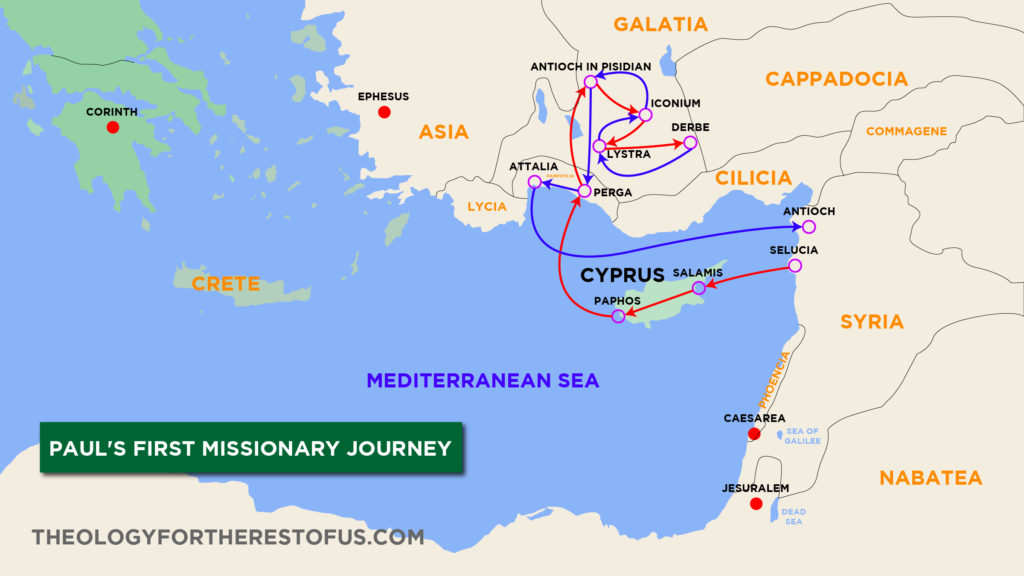
Barnabas and Saul sensed the call of the Holy Spirit to go out on their first missionary journey (Acts 13-14). Sometime around 46 A.D. (or 47 A.D.), Barnabas and Saul were set apart by the Holy Spirit and sent out on their first missionary journey by the church at Antioch.
Before Barnabas and Saul officially left on their first missionary journey, they recruited a young man named John Mark to go with them. John Mark was the son of a woman named Mary (mentioned in Acts 12:12). She owned the house where the Christians had been meeting and praying when Peter was miraculously delivered from jail by the angel.
It is likely that, as a young boy, John Mark had witnessed Jesus’ ministry first-hand. Sadly, however, during the missionary journey, John Mark would eventually abandon Barnabas and Saul. This would later lead to a significant dispute between Barnabas and Saul a few years in the future.
Barnabas and Saul sailed from Seleucia to the island of Cyprus, apx. 100 miles off the coast of Syria. They began by preaching to Jewish people in the synagogues of Salamis. The crew did ministry in several parts of the island until they got to Paphos (Acts 13:4-6).
During their ministry they faced significant opposition. One of their earliest opponents was a magician who was a Jewish false prophet. Saul performed a supernatural act that blinded this false prophet. These events led to the conversion of the Roman proconsul Sergius Paulus (Acts 13:6-12).
Saul Becomes Paul
After the events in Cyprus, the author of the book of Acts, Luke, begins to refer to Saul as Paul. Some Christians have asserted that Saul changed his name. However, it’s more likely that Saul and Paul were two different names for the same person all along; he was known by both names for many years.
After launching a Gentile-focused ministry, Paul would have been interacting with many Gentiles, and they would have likely preferred to refer to him by the Gentile name. It appears Luke sought to make this a point of emphasis. Scholar Greg Lanier says :
“When Saul Paul launches his Gentile-focused ministry among primarily Greek-speakers (beginning with Acts 13:9), it’s natural for Luke, the author of Acts, to begin referring exclusively to him by his Greek name. Nor is it surprising that he’s later referred to as ‘Paul’ in Jerusalem, since there were Greek speakers there too. Indeed, Luke could be making a thematic point by shifting from Saul to Paul around chapter 13, given the broader theme of Acts (e.g., 1:8). After all, the church’s nucleus is shifting from predominantly Jewish-centered Jerusalem to the Greek-centered ‘ends of the earth,’ such as Rome.”
Pamphylia and Galatia
Barnabas, Paul, and John Mark then traveled across the Mediterranean Sea to Perga in Pamphylia. This is where John Mark deserts Paul and Barnabas and heads back to Jerusalem (Acts 13:13).
From Perga, Paul and Barnabas then continued northward into the province of Galatia, coming to the city of Antioch in Pisidia (not to be confused with their home base city of Antioch in Syria).
Archaeologists have discovered an inscription containing the name ‘Sergius Paulus’ in the city of Antioch in Pisidia (he was the Roman proconsul that became a Christian back on the island of Cyprus). This is strong evidence that Sergius Paulus had family roots in Antioch in Pisidia. Some scholars have argued that he was the person that probably encouraged Barnabas and Paul to travel up to Antioch in Pisidia.
Once they arrived in Antioch in Pisidia, Paul went to the synagogue and preached about the good news of Jesus. Paul effectively preached in the synagogue for multiple weeks. This resulted in many people coming to faith in Jesus (Acts 13:14-44).
Unfortunately, Barnabas and Paul faced significant opposition there too. Part of the problem they faced was the jealousy of certain Jews. There were many Gentiles showing up to hear the gospel preached. Some Jews became jealous and started to contradict what Paul had to say. Since the Gentiles were more willing to hear what Paul had to say, he turned and preached to the Gentiles.
And when the Gentiles heard this, they began rejoicing and glorifying the word of the Lord, and as many as were appointed to eternal life believed. —Acts 13:48
The Gentiles’ response to the gospel was positive. The gospel continued to spread amongst Gentiles, but yet again the jealousy of the Jews became a significant issue. The Jews eventually drove Barnabas and Paul out of Antioch.
After leaving Antioch in Pisidia, they traveled eastward, further into the Galatian region, arriving at the city of Iconium. There they preached and did miracles in the name of Jesus.
Very similar to what had happened in Antioch, Paul went into the synagogue in Iconium to teach and the result was that many Jews and Greeks believed in Jesus, but the unbelieving Jews there stirred up trouble against Paul, dividing the city (Acts 14:1-4). Barnabas and Paul left the city when they heard about attempts to stone them (Acts 14:5).
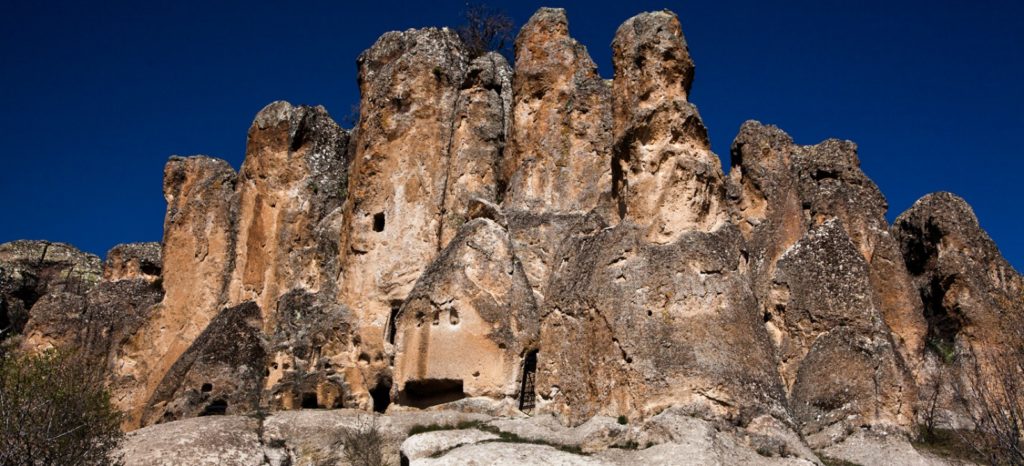
Lystra and Derbe
They then came to Lystra. There Paul performed a miracle causing a crippled man to walk again. When this occurred the people of the area assumed Barnabas and Paul were gods. The priest of Zeus brought animals to offer as sacrifices to Barnabas and Paul. When Barnabas and Paul realized what was happening, they tore their clothes in lament and told the people of the one true God (Acts 14:8-18).
The Jewish unbelievers from Antioch and Iconium had come to Lystra too, stirring up trouble. They convinced the people of Lystra to stone Paul and left him for dead outside the city. But Paul wasn’t dead. He got up walked back into the city (Acts 14:19-20).
The book of Acts doesn’t give us details about the events of that day when Paul walked back into the city, but I imagine the city’s residents were shocked. It was quite rare for anyone to survive stoning.
Barnabas and Paul then continued onto Derbe the next day. They preached and “won a large number of disciples” (Acts 14:21). Archeologists have discovered several inscriptions that show the Christian faith was a major presence in the city of Derbe after Barnabas and Paul’s visit.
Facing Tribulations for the Sake of Discipleship
Barnabas and Paul began their trek back home, but they decided that they’d first travel back through Galatia. When you look at a map, you see that it would have been much faster (and likely easier) to travel from Derbe directly to Antioch in Syria.
Derbe is less than 260 miles away from Antioch in Syria and less than 140 miles away from Paul’s original hometown of Tarsus. Barnabas and Paul could have traveled eastward through the region of Cilicia. Paul was very familiar with Cilicia and likely had friends throughout the region that could give them safe refuge along the way.
But Barnabas and Paul intentionally traveled more than 280 miles in the opposite direction of Antioch in Syria. Even though they had suffered great persecution in Galatia, they wanted to go back through the Galatian cities, before heading home, because they wanted to strengthen the disciples in those cities.
They returned to Lystra and to Iconium and to Antioch, strengthening the souls of the disciples, encouraging them to continue in the faith, and saying that through many tribulations we must enter the kingdom of God. —Acts 14:21-22
The journey through these cities for a second time gave them the opportunity to teach doctrine, establish elders in the churches, and pray with the believers.
After this, Barnabas and Paul then continued back down to Perga in Pamphylia. They preached in that region for a time. They eventually made their way over to the nearby port city of Attalia and sailed from there to Antioch in Syria (Acts 14:24-28).

Return to Antioch
Barnabas and Paul returned back home to Antioch in Syria stay there after the trip for “a long time” (Acts 14:28).
They had traveled more than 800 miles. Their first missionary journey had probably lasted between one and two years. When Barnabas and Paul arrived back in Antioch in Syria, they shared with everyone about the many people who had come to faith in Jesus and the churches that were established.
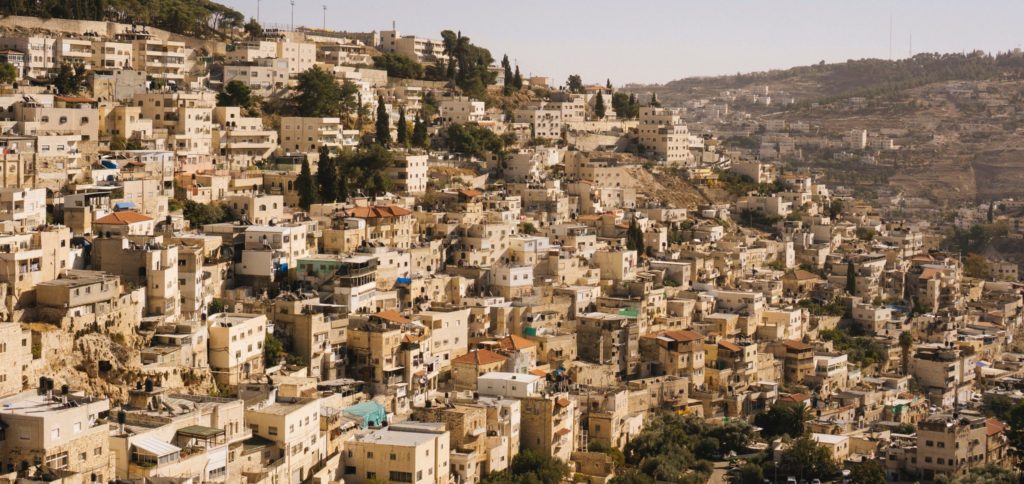
Jerusalem Council
After returning, Barnabas and Paul learned about a particular faction from Judea that had been confusing many Christians in the region by preaching a false gospel. This group had been preaching that, in order to become a Christian, the Gentiles must follow the Old Testament law, including circumcision (Acts 15:1).
Barnabas and Paul seem to have spent significant time disputing this false message and debated the Judean faction.
Eventually, this debate, about this false gospel, was appealed to the apostles in Jerusalem (Acts 15:2). This led to the Jerusalem Council (Acts 15:3-35), which likely took place sometime in 50 A.D. (some scholars date this event as early as 48 A.D. and some date it as late as 51 A.D.).
While traveling to Jerusalem for the council, Barnabas and Paul made stops along the way throughout Phoenicia and Samaria, encouraging believers wherever they went.
At the council, all the apostles concluded that the Gentiles do not need to follow the Jewish laws in order to become Christians. Barnabas and Paul (as well as several other men who had been at the council) headed back to Antioch to declare the good news. After the council they stayed in Antioch “some days” (Acts 15:36).
Paul and Barnabas Separate
Not long after the Jerusalem Council, Barnabas and Paul began planning their second missionary journey. They believed it was essential that they go to the Gentile world to proclaim the statements that came from the council.
Originally, Barnabas and Paul had intended to go out together again, however, they had a “sharp disagreement” (Acts 15:39). The source of this dispute was John Mark. Barnabas wanted John Mark to come along again, but Paul was against this idea since John Mark had deserted them on their previous missionary trip when they were in Pamphylia. Paul saw John Mark as a liability.
Due to this sharp disagreement, Barnabas and Paul would go on separate missionary journeys. Barnabas took John Mark and sailed to Cyprus. Paul took a young man named Silas and traveled by land (Acts 15:39-41).
Paul’s Second Missionary Journey
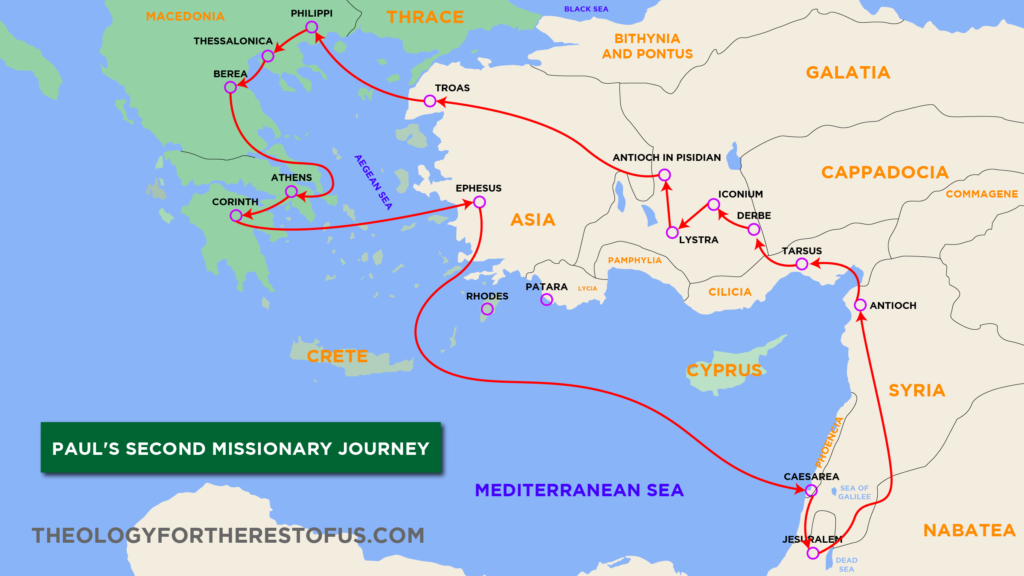
Paul likely started his second missionary journey (Acts 15-18) sometime late in 50 A.D. or early in 51 A.D. (but some scholars date both the council of Jerusalem and the launch of this missionary journey as early as 48 A.D.).
Paul and Silas started by traveling northwestward by land through the region of Cilicia. The Roman road that they would have used went directly through Paul’s hometown of Tarsus. I imagine this would have given Paul the sweet opportunity to reconnect with many old friends.
Paul and Silas made stops in the churches all throughout the region, along their way, “strengthening” believers (Acts 15:41).
Return through Galatia
Paul and Silas continued their travels westward into Galatia. They spent significant time in several Galatian cities including Derbe, Lystra, and Iconium, connecting with the churches that Paul had planted with Barnabas on this first missionary journey.
Paul and Silas taught the believers throughout Galatia what had been decided at the council in Jerusalem and the “churches were strengthened in the faith, and they increased in numbers daily” (Acts 16:5).
Paul Circumcises Timothy
Along the way, Paul and Silas meet a young man named Timothy from that region. He had a good reputation. Paul decided to let Timothy accompany them. However, Paul first circumcised Timothy (Acts 16:3).
It seems that Paul knew that having an uncircumcised man like Timothy with him could somehow impede the advance of the gospel wherever they preached.
Paul intended to continue to preach that circumcision was not necessary for salvation. But Paul knew that Timothy’s presence could potentially cause their opponents to claim that the only real reason that Paul was making these claims is because he had an uncircumcised friend (Timothy).
Paul’s Ministry Restricted
Paul and his crew traveled throughout the “region of Phrygia and Galatia” (Acts 16:6) looking for opportunities to preach the gospel in Asia (modern-day southwest Turkey), but they were restricted from doing so multiple times. They then traveled to the region of Mysia (modern-day northwest Turkey), attempting to eventually make their way northward toward Bithynia, but multiple times they were restricted or diverted by the Spirit (Acts 16:7).
It seemed that God’s providence was leading them somewhere other than what Paul had originally intended. They passed through Mysia again and eventually ended up in the city of Troas near the cost of the Aegean Sea.
Luke Joins the Team
In Troas, Luke joins their missionary crew. The book of Acts does not explicitly state this, but it’s implied. Throughout most of the book of Acts, Luke speaks in the third person. However, starting in Acts 16:10, Luke begins to speak in first person, as if he had joined the team by that point.
Luke would become one of Paul’s ministry protégés. He was a Greek physician, but he also functioned as an investigative journalist. He eventually writes both the Gospel of Luke and the book of Acts. Some scholars have also suggested that Luke wrote the book of Hebrews.
Macedonian Call and Travel to Philippi
While at Troas, Paul received a vision. This vision was of a Macedonian man asking for Paul to come and help them (Acts 16:9-10). After receiving this vision they sailed across the Aegean Sea to the island of Samothrace, and then onto Neapolis (modern-day northeastern Greece).
The missionary crew then traveled to Philippi where they stayed for “some days” (Acts 16:12). While there, they preached the gospel. One specific woman they met was Lydia. She became a believer along with the rest of her household and invited Paul and his companions to stay (Acts 16:13-15).
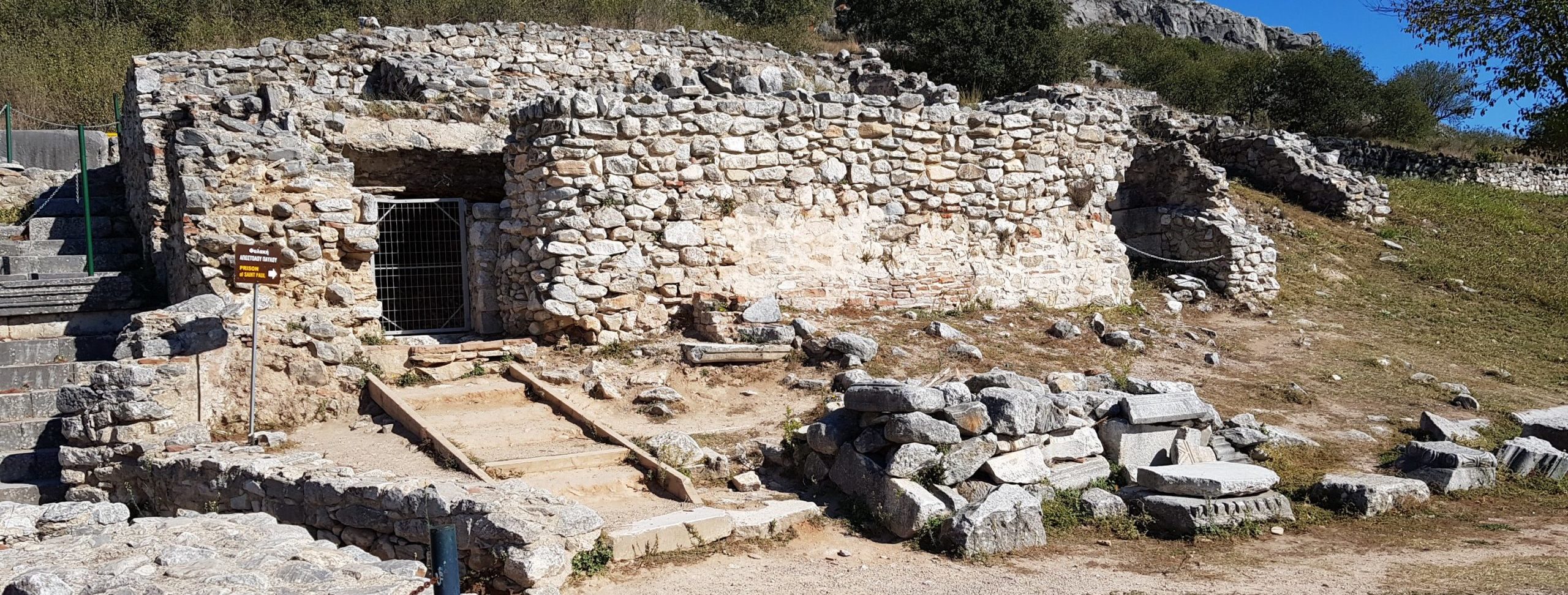
Paul and Silas Jailed in Philippi
While in Philippi, Paul and Silas met a slave girl who was demon possessed. Her owners made money off of her because the demon gave her the ability to function as a fortune-teller. For several days she followed Paul and Silas around, declaring that Paul and Silas were preachers of the one true God (Acts 16:16-18).
Paul cast the demon out of her. The girl’s owners realized that they wouldn’t make any more money from her, because she could no longer function as a fortune-teller. They were angry so they took Paul and Silas to the magistrates. Paul and Silas were beaten with rods and thrown into jail. Paul had previously been beaten and persecuted, but this marked the first time he was officially imprisoned (Acts 16:18-24).
While in prison, Paul and Silas prayed and sung hymns to the Lord. As they sang and prayed many of the other prisoners listened. Late in the night an earthquake occurred, this earthquake not only opened all the doors but broke their chains.
The jailer believed that all the prisoners had escaped and was about to kill himself (the Romans would’ve blamed the guard and likely would’ve executed him). But Paul and Silas stopped him and told him that no one had escaped. Then the jailer responded asking how to be saved.
And they said, “Believe in the Lord Jesus, and you will be saved, you and your household.” —Acts 16:31
God turned the persecution into an opportunity for gospel proclamation. Paul and Silas were not only able to witness to the jailer but all the prisoners listening to their hymns and prayers throughout the night. Paul went to the jailers home to preach and several people came to faith (Acts 16:25-34).
When the town magistrates learned that Paul and Silas were Roman citizens, the magistrates apologized for having unlawfully imprisoned them. This was a public vindication (of sorts) for Paul and Silas. Before leaving, Paul and Silas spent more time with Lydia and the other new converts in the region, encouraging them in the faith (Acts 16:35-40).
Thessalonica
Next, Paul and his crew passed through Amphipolis and Apponia and came to Thessalonica (Acts 17:1). As was his habit, Paul first went to the synagogue to preach to the Jews. He preached there on three consecutive Sabbath days. Many people believed, including many Gentiles.
Yet again, as Paul had seen before, many Jews became angry and jealous, and they caused an uproar. One of the brothers that had welcomed Paul was a man named Jason. The Jews dragged Jason before the city’s leaders. Jason was eventually released.
Paul and Silas left the city. It does seem that the church in Thessalonica continued to face persecution and trouble from their countrymen, but they flourished anyway. We read these words in Paul’s letter to the church:
For you, brothers, became imitators of the churches of God in Christ Jesus that are in Judea. For you suffered the same things from your own countrymen as they did from the Jews. —1 Thess. 2:14
Paul and his crew went to Berea. There, Paul yet again started in the Jewish synagogue, but this time he got a different response. Instead of jealousy and mobs, the Jews there examined the Scriptures to see if what Paul was saying was true. Many believed in Jesus.
Paul praised their willingness to study and pursue truth. Luke says the Jews of Berea were “more noble” than the Jews of Thessalonica (Acts 17:11).
Things seem to be going well. Many people became Christians. But the Jews from Thessalonica heard that Paul was teaching in Berea and they came to stir up the crowds and trouble. Paul was sent away by the brothers there, but Silas and Timothy stayed behind (Acts 17:13-14).
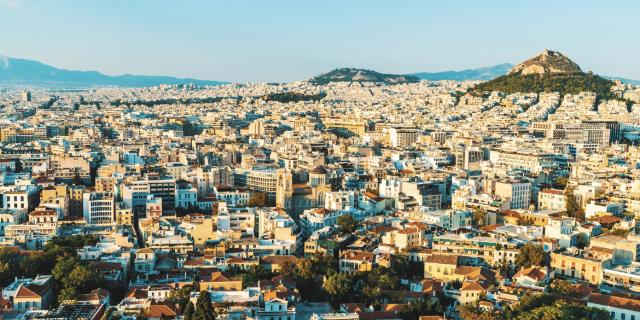
Traveling in Achaia
The apostle Paul was then escorted by some brothers more than 300 miles south, into the region of Achaia, reaching the city of Athens. When they arrived in Athens, the brothers headed back. Paul stayed in Athens, but told the brothers to tell Silas and Timothy that he wanted them to join him as soon as possible (Acts 17:15).
While Paul waited for Silas and Timothy, Paul’s “spirit was provoked within him” (Acts 17:16) because he saw an abundance of idols in the region.
Paul decided to make the best use of his time and talked with the Jews at the synagogue and preached to many Gentiles in the marketplace (Acts 17:17). Paul also talked with Epicurean and Stoic philosophers (Acts 17:18). They eventually brought Paul to the Areopagus, the court where men discussed philosophy, civics, and religion.
In the court of the Areopagus, Paul preached one of his most famous sermon (Acts 17:22-31). Paul’s sermons included quotes from famous Greek philosophers that they would have been familiar with. This gives us insights into Paul’s knowledge of their culture and insights into Paul’s missiology.
After hearing Paul’s sermon, there were some there who laughed at him, but there were also some who believed the gospel and joined Paul (Acts 17:32-34).
First Visit to Corinth
After leaving Athens, Paul traveled 53 miles southwest to Corinth. By this point in his second missionary journey, Paul had traveled more than 1,500 miles.
The apostle Paul probably arrived in Corinth apx. 8-12 months after the start of the second missionary journey, therefore, it’s likely that he got there sometime late in the year of 51 A.D. (or maybe sometime early in 52 A.D., depending on how we date his departure from Antioch in Syria). Paul stayed in Corinth for a year and a half (Acts 18:11), so Paul was likely in Corinth until the summer or fall of 53 A.D.
Silas and Timothy also rejoined Paul in Corinth.
While in Corinth, Paul met two Jews from Rome, Aquila and Priscilla. Like the apostle Paul, Aquila and Priscilla were also tentmakers. Paul stayed with them and worked while also going to the synagogues on the Sabbath to preach, seeking to convert both Jews and Greeks (Acts 18:1-4).
Paul faced some opposition from Jews in Corinth (Acts 18:5-9), but many people in the city believed anyway. Paul may have been considering leaving the city, but he stayed in Corinth after having received a vision from God that told him that “no one will attack or harm you” (Acts 18:10).
While in Corinth the apostle Paul wrote his letters to the Thessalonians, encouraging the new believers there to stand firm under the pressure and pain of persecution. He gives them instructions on how to live a godly lifestyle and gives doctrinal teaching about the future second coming of Christ.
Paul continued to preach the word of God faithfully for those 18 months. Many were saved and the church was established. But many Jews were upset.
The Jews of Corinth eventually tried to bring the apostle Paul before the Roman proconsul Gallio, who happened to be the older brother of the renowned dramatist and philosopher Seneca (the tutor of Emperor Nero). Gallio refused to even hear their case against Paul and sent them away (Acts 18:12-17).
Paul stayed in Corinth for “many days longer” (Acts 18:18) after being brought before Gallio. He then started his journey back home to Antioch in Syria, but planned to first make a stop in Ephesus. Priscilla and Aquila came with him.
Leaving from Cenchreae
Paul’s crew traveled to the nearby port city of Cenchreae, just eight miles from Corinth. We don’t know how long they stayed in Cenchreae, but they were there long enough for Paul to have his head shaved as part of a vow (Acts 18:18). It’s possible that this stop was very brief, but it’s also possible that they spent some time preaching and ministering there in the city.
There does seem to be some evidence that Paul spent some significant time in Cenchreae. But we cannot be certain. Also, we’re not sure if he spent time there during this second missionary journey or if that happened at a later time during his third missionary journey.
Brief Visit to Ephesus
When Paul arrived in Ephesus, he went into the synagogue to talk with the Jews about Jesus. His visit to Ephesus was brief. They requested that he stay in the city longer. He declined but said, “I will return to you if God wills” (Acts 18:21). Paul made plans to leave, but Priscilla and Aquila stayed in the city.
Paul traveled from Ephesus to Caesarea. Once he was there he visited with the believers in the region and preached the gospel in various towns and places. He briefly visited Jerusalem and then traveled back home to Antioch in Syria.
Paul’s second missionary journey lasted between two and a half years and three years, and likely ended back in Antioch sometime in the fall of 53 A.D. (or maybe early 54 A.D.).
Paul’s Third Missionary Journey
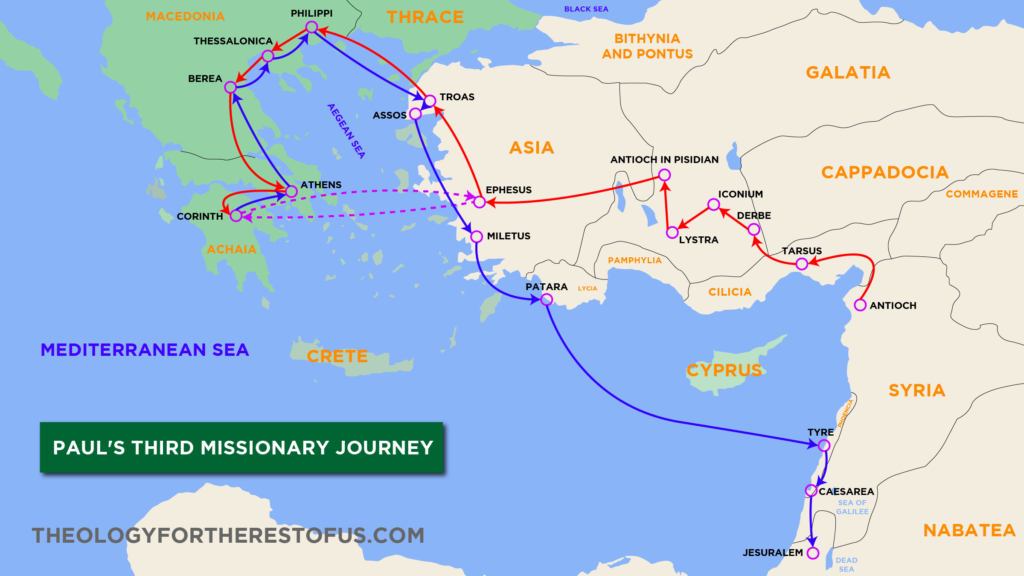
After getting back from his second missionary journey, the apostle Paul stayed Antioch for “some time” (Acts 18:23). Maybe just a few weeks or few months. He then launched his third missionary journey (Acts 18-21).
Paul likely left for his third missionary journey in the spring of 54 A.D. This third missionary journey was probably more than four years long and ended with Paul in Jerusalem in 58 A.D.
Galatia and Phrygia
Paul began his third missionary trip by visiting many of the same locations that he had visited on his first and second missionary journeys. We don’t know his exact route, but it’s likely he began by traveling through the region of Cilicia and through the city of Tarsus, on the way toward Galatia.
He spent several months traveling to the churches throughout the regions of Galatia and Phrygia, “strengthening all the disciples” (18:23). Paul passed through the “inland” route through Asia and traveled west to Ephesus (Acts 19:1).
Three Years in Ephesus
Paul spent three labor-intensive years in Ephesus (Acts 20:31). Paul was likely in Ephesus from the fall of 54 A.D. to the fall of 57 A.D.
Paul’s time in Ephesus was hard. He later says that he experienced many “afflictions” and he wasn’t confident that he would live through this season (2 Cor. 1:6-10). But God did many great things through Paul while he was in Ephesus.
For the first few months of Paul’s ministry in Ephesus, he spent time preaching in the synagogue. That was his focus. However there were many Jews stuck in unbelief, and they said evil things about Paul and the gospel message. So Paul decided to spend the last two and half years of his time in Ephesus preaching in the hall of Tyrannus, instead of the synagogue. He preached in the hall of Tyrannus daily and “all residents of Asia heard the word of the Lord” (Acts 19:10).
During Paul’s ministry, he performed many miracles in the name of Jesus, leading many to believe.
“God was doing extraordinary miracles by the hands of Paul… even handkerchiefs or aprons that had touched [Paul’s] skin were carried away to the sick, and their diseases left them and the evil spirits came out of them.” —Acts 19:11-12
God-Fearers Received the Holy Spirit
One of the most famous events from Paul’s time in Ephesus was when he corresponded with a group of disciples that had known about John’s baptism (referring to John the Baptist), but they did not know about Jesus (Acts 19:1-3). These types of believers were sometimes referred to as God-fearers.
These God-fearers had previously been taught by a great preacher named Apollos. He had taught them to revere the one true God, the God of Israel. But Apollos himself had not known about Jesus until after he had preached to this particular group of disciples. Apollos was later instructed by Paul’s friends, Priscilla and Aquila (Acts 18:24-28).
Paul taught this particular group about Jesus. They believed and received the Holy Spirit (Acts 19:4-7).
The Sons of Sceva
Another event that the book of Acts highlights, from Paul’s time in Ephesus, is about seven traveling Jewish exorcists, the sons of Sceva. These exorcists came across a demon-possessed man. They attempted to cast-out the demons (Acts 19:11-14). But one of the demons responded to them, “Jesus I know, and Paul I recognize, but who are you?” (Acts 19:15).
The demon-possessed man (under the control of the evil spirits) attacked the seven men and badly beat them (Acts 19:16). This caused many people in the region to respect Paul and his ministry. Many of the magicians in the area repented and burned their magic books (Acts 19:17-19) and “the word of the Lord continued to increase in the region” (Acts 19:20).
Demetrius, Riots, and Leaving Ephesus
Paul was planning to leave Ephesus. However, before he left Ephesus, a silversmith named Demetrius caused trouble. Demetrius made and sold idols. Paul preached against idolatry, so many people stopped buying Demetrius’ idols. This cost him money. Demetrius clearly was not happy.
There were other business owners that were also hurt financially because of Paul’s preaching. Many people had stopped buying their idols as they responded to the gospel. When these merchants got together, they started a massive riot in the city.
Paul wanted to go into the crowd to calm them down, but the disciples would not let him because they knew that Paul could get killed. Some of the Christians went into crowd and calmed the riot. Shortly after these riots, Paul set sail for Macedonia (Acts 19:21-20:1).

The “Painful” Visit
Paul had made plans to travel through Macedonia and then southward into Achaia (1 Cor. 16), which would likely include a visit to the church in Corinth.
At some point, Paul received some correspondence telling him that there were massive problems in the church of Corinth. How did Paul respond when he received this news? There are two main views from scholars.
View #1: Paul immediately changed plans and left from Ephesus to Corinth.
Some scholars argue that as soon as Paul received word that there were big problems in Corinth, Paul changed his plans and decided to visit the Corinthians immediately, skipping his original plans to travel through Macedonia.
Paul probably thought that once he was there in Corinth, that he’d be able to resolve the conflicts. But it seems that the exact opposite happened. Paul would later describe this visit as “painful” (2 Cor. 2:1). During this “painful” visit Paul was deeply hurt by someone in the church (2 Cor. 2:5).
The scholars that embrace View #1 say that Paul then left Corinth after this “painful visit” and headed back to Ephesus for a brief period of time.
It then appears that Paul was contemplating returning to Corinth, yet again, before heading over to Macedonia, but Paul ultimately decided against this additional visit, in order to “spare” the Corinthians (2 Cor. 1:23). Paul defends this decision in 2 Corinthians (vv. 1:12-2:2).
Paul then left from Ephesus to Macedonia (Acts 20:1). However, Paul would eventually make a third visit back to Corinth a few months later toward the end of this journey.
These scholars typically piece it all together like this:
- Paul (while in Ephesus) receives news of trouble in the church of Corinth and changes his plans
- Travels from Ephesus to Corinth for a second visit (known as the “painful” visit)
- Travels from Corinth back to Ephesus
- Contemplates another visit to Corinth, but decides against it
- Experiences the Demetrius-led riots in Ephesus
- Travels onto to Macedonia
- Goes from Macedonia down into Greece
- Eventually makes it back to Corinth (third overall visit)
Scholars that hold to View #1 assert that Paul ultimately made three total visits to Corinth; his first visit (the 18 months he spent there during his second missionary journey), the “painful” visit from Ephesus, and then a third visit toward the end of this third missionary journey.
View #2: Paul did not change his plans, but visited Corinth later.
Scholars that hold to View #2 say that Paul likely received some communication from Corinth (that there were indeed big problems in the church), but these scholars conclude that receiving this communication did not cause Paul to visit Corinth immediately.
The scholars that embrace View #2 argue that Paul did consider changing his plans, which would have consisted of a visit to Corinth before going through Macedonia, but these scholars argue that ultimately Paul decided against going to Corinth immediately, so he stuck to his plans to travel through Macedonia. They interpret Paul’s words in 2 Corinthians (vv. 1:12-2:2) as Paul giving a defense as to why he did not visit them.
These scholars say that eventually Paul did visit Corinth, a few months later, toward the end of his third missionary journey. Scholars that embrace View #2 often say that the word “painful” (2 Cor. 2:1) was not a description of an actual visit that ever happened, but that it was a description of the type of visit that would have ensued if Paul had indeed visited them. He knew that if he did visit, it would have been painful, so he sought to “spare” them (2 Cor. 1:23).
- Paul (while in Ephesus) receives news of trouble in the church of Corinth
- Contemplates an immediate visit to Corinth, but ultimately decides against it
- Goes from Ephesus to Macedonia
- Eventually travels to Corinth for his second visit
Scholars that hold to View #2 assert that Paul ultimately made two total visits to Corinth; his first visit (the 18 months he spent there during his second missionary journey) and then his visit to Corinth toward the end of this third missionary journey.
Leaving For Macedonia and the Sorrowful Letter
Paul leaves Ephesus and heads toward Macedonia. In the book of Acts, Luke gives us no details. He only says that Paul “departed for Macedonia” (Acts 20:1). However, by examining Paul’s letters, we get more insight into these travels.
It appears that, at some point during this journey, Paul had sent Titus to Corinth with a letter (this is sometimes referred to as the “sorrowful letter”). Paul later describes this “sorrowful” letter as having been written with “much affliction and anguish of heart and with many tears” (2 Cor. 2:4).
Some scholars contend that this “sorrowful letter” is the epistle that appears in the New Testament, that we know today as 1 Corinthians. Other scholars argue that the “sorrowful letter” is a separate correspondence that has been lost to history.
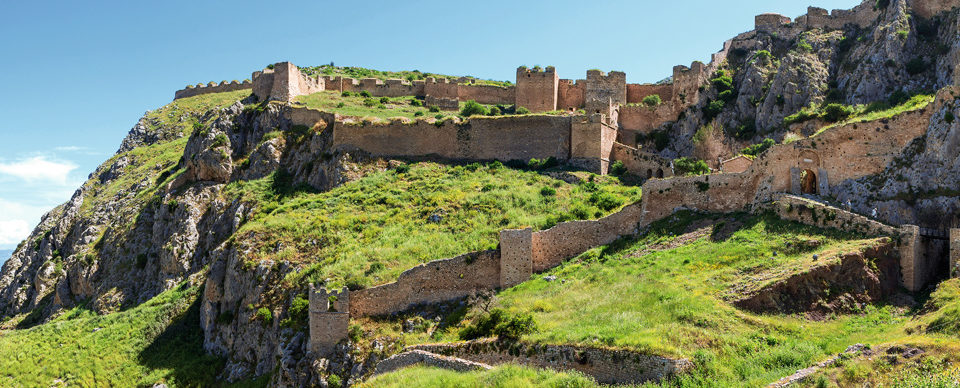
Ministry in Troas and Macedonia
On the way to Macedonia, Paul stopped in Troas to preach there and to await Titus’ return from Corinth. While waiting in Troas, Paul had great ministry opportunity. He called it an “open door” (2 Cor. 2:12).
However, when Titus’ return from Corinth appeared to be delayed, Paul was concerned for Titus’ safety. Paul decided to leave Troas and traveled to Macedonia to find Titus (2 Cor. 2:13).
Paul traveled throughout Macedonia, visiting the churches and friends in the region, and encouraging the believers in those churches (Acts 20:2).
Finally, while in Macedonia, Paul was reunited with Titus. Titus reported that many people in the church of Corinth had repented after hearing Paul’s letter (2 Cor. 2:5-11; 7:5-16). Paul was filled with joy.
However, Titus also reported that Paul’s opponents still wielded some influence over a small rebellious faction within the church questioning Paul’s authority and credibility. Paul responded to this faction by writing another letter (most likely from Philippi). This letter is in our New Testament, known today as 2 Corinthians.
Three Months in Greece
After these travels through Macedonia, the apostle Paul eventually traveled southward and finally arrived in Greece (i.e., Achaia). He stayed in the region for three months (Acts 20:2-3), including a lengthy stay in Corinth. This stay likely took place in late 57 A.D. or early 58 A.D.
While in Corinth, Paul wrote his theological masterpiece, the letter to the Romans.
As previously discussed in this article, some scholars believe that this was Paul’s second visit while others argue that this was his third visit.
Cenchreae and Phoebe
It’s also possible that during these three months in Achaia, Paul spent time in the nearby city of Cenchreae. In the book of Romans, Paul mentions Phoebe, a deaconess in the church of Cenchreae (Rom. 16:1).
Phoebe was the person that delivered Paul’s letter to the Romans, and Paul asked them to welcome her, praising her for being a “patron of many” (Rom. 16:2). It’s highly unlikely that Paul would have asked her to make this important delivery for him unless he knew her well and trusted her, pointing to the likelihood that Paul had spent time in Cenchreae before writing that letter.
As previously mentioned in this article, it’s also possible that Paul had spent some time in Cenchrea during his second missionary journey as well as this third missionary journey.
One More Lap Through Macedonia
After his time in Achaia, Paul had originally intended to sail directly to Jerusalem. Those plans were changed, however, when it was discovered that some of Paul’s opponents had been plotted against him. Paul decided to take another lap through Macedonia instead (Acts 20:3).
Paul had many companions with him, from various churches, which gave him protection while he traveled through Macedonia (Acts 20:4-5).
Throughout the spring of 58 A.D., Paul traveled through the Macedonian region, visiting towns such as Berea and Thessalonica, and eventually ending up in Philippi (again) during the “days of unleavened bread” (Acts 20:6).
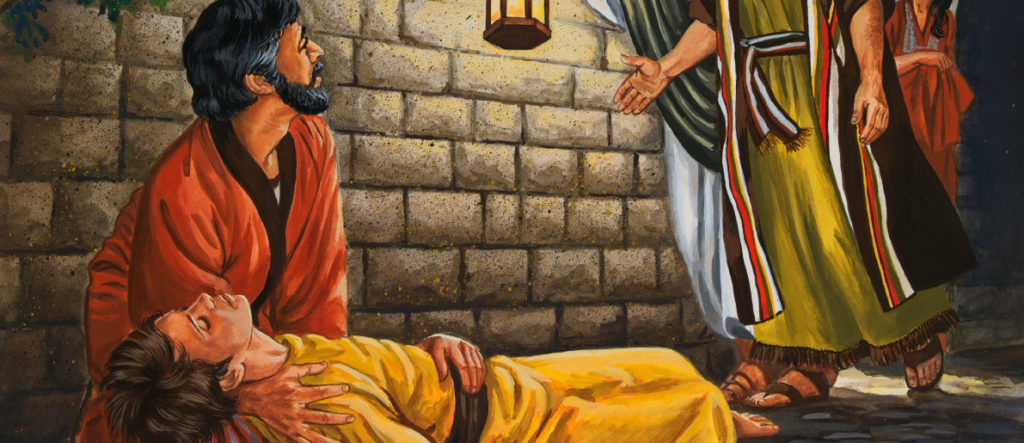
Eutychus Raises from the Dead at Troas
Paul and his companions then traveled to Troas (Acts 20:5). He ministered there again for a week. It was in Troas that a young man, Eutychus, was listening to one of Paul’s sermons and fell three stories out a window. When they found him he was dead on the ground, but Paul supernaturally restored life to this man (Acts 20:6-12).
After Troas, Paul’s companions went by ship to Assos, but Paul went by foot. Luke doesn’t tell us precisely why Paul did this. But what we do know is that distance from Troas to Assos was more than 30 miles through dangerous and mountainous terrain.
After meeting with his companions in Assos, they began their trek to Jerusalem. They made briefs stops in Chios and Samos, before arriving in Miletus (Acts 20:15).
Goodbye to the Ephesian Elders
It would make sense that Paul would have wanted to stop in Ephesus before heading to Jerusalem. considering the dear friends he had there, but he intentionally passed Ephesus because he wanted to be in Jerusalem by Pentecost, and he knew that traveling through Ephesus, and staying in Asia, would take much more time than he desired. In addition, he knew visiting Ephesus again could cause an uproar (Acts 20:13-16).
However, Paul did want to see his Ephesian friends and ministry partners, so when he arrived in Miletus, Paul called the elders from Ephesus to meet him there (Acts 20:17). In Miletus he encouraged the elders and commended them, letting them know that he would not be seeing them again since he knew that imprisonment and maybe death waited for him in Jerusalem. This was, no doubt, an emotional moment for Paul and his friends.
Paul had spent several years laboring with these men in ministry, and now he was saying goodbye for, what appeared to be, the last time. They wept and prayed together (Acts 20:17-38).
Sailing for Syria
From there, the apostle Paul and his companions then sailed towards Syria. They made brief stops in Cos, Rhodes, and Patara, before finally coming to Syria, landing at Tyre (Acts 21:1-3). Paul and his companions spent seven days with the disciples in Tyre. Through “the Spirit” they told Paul not to go onto Jerusalem, but Paul sensed that Jerusalem was the right place to go (Acts 21:4).
Then Paul and his companions went to Ptolemais (Acts 21:7), spending one day with the believers there, before heading onto Caesarea. There they were greeted by the believers there and they stayed with Philip the evangelist (Acts 21:8). While they were there, a prophet named Agabus came down from Judea and told Paul of the coming affliction he would face in Jerusalem (Acts 21:10-12).
Despite many people again urging Paul not to go to Jerusalem, Paul told them he knew what was instore and that he was ready to die.
Then Paul answered, ‘What are you doing, weeping and breaking my heart? For I am ready not only to be imprisoned but even to die in Jerusalem for the name of the Lord Jesus.’ —Acts 21:13
Paul and his companions then traveled to Jerusalem and was greeted by his brothers in Christ who lived there. He told the church there all God had been doing among the Gentiles (Acts 21:14-16). Once there, Paul visited with James and all the elders (Acts 21:17-18). He told them about all that God had done throughout the Gentiles.
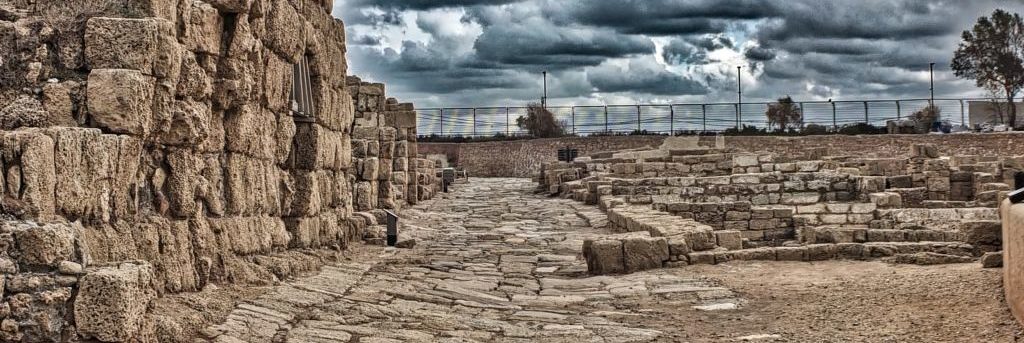
Arrested in Caesarea
While in Jerusalem, Paul went to the temple to worship and pray. While he was there, some Jews from Asia Minor stirred up trouble for Paul. They accused him of abandoning the one true God of Israel, of maligning the law of Moses, and of encouraging people to disobey the Jewish laws. Paul (obviously) denied this charge. This confrontation caused a riot in the temple. Paul was dragged out of the temple by a mob. The Romans then intervened and took Paul into custody (Acts 21:27-36).
Paul then addressed the crowd. He made it clear that he loved the law of God and that he had previously been a persecutor of Christians. But that he had become a preacher of the gospel after meeting Jesus on the road to Damascus. This caused another riot to erupt. The Romans then took Paul in their barracks. The Romans were going to flog him but Paul appeals to his own Roman citizenship (Acts 21:37-22:29).
On Trial Before Felix
Paul is taken to the Roman barracks in Caesarea. During this time the Roman governor over the region, Felix, brought Paul to trial. Ananias, the high priest, came from Jerusalem to bring charges against Paul. Felix gave Paul the opportunity to speak before the crowd. Paul shares his story and preaches truth. Felix was afraid of Paul’s message, so he doesn’t seemingly know what to do with Paul (Acts 23:23-35; 24:1-27).
Paul was imprisoned in Caesarea by the Romans for two years, but was given “some freedom” and his friends are allowed to visit him “to take care of his needs” (Acts 24:23).
On Trial Before Festus and Agrippa
When Festus became the governor of the region in 60 A.D. (or maybe earlier in 59 A.D.), he brought Paul back to trial. Some Jews came from Jerusalem again to bring charges against Paul, but they could not prove any of those charges (Acts 25:1-12).
King Herod Agrippa II visited with Festus. Festus asked him to hear Paul’s case. When Paul is called to defend himself, he gives one of his most famous defenses of the gospel and even encourages Agrippa to believe in Jesus (Acts 26:1-29). Agrippa famously responds, “Do you think that in such a short time you can persuade me to be a Christian?” (Acts 26:28). Paul says that he wants everyone to believe.
Festus calls Paul crazy (Acts 26:24), but both he and Agrippa agree that Paul had not done anything that might “deserve death or imprisonment” (Acts 26:31). Paul could have simply “been set free if he had not appealed to Caesar” (Acts 26:32). Paul had appealed to Caesar under his rights as a Roman citizen. This set into the motion the plans for Paul to be transported from Palestine to Rome to face trial in Caesar’s court.
Journey to Rome
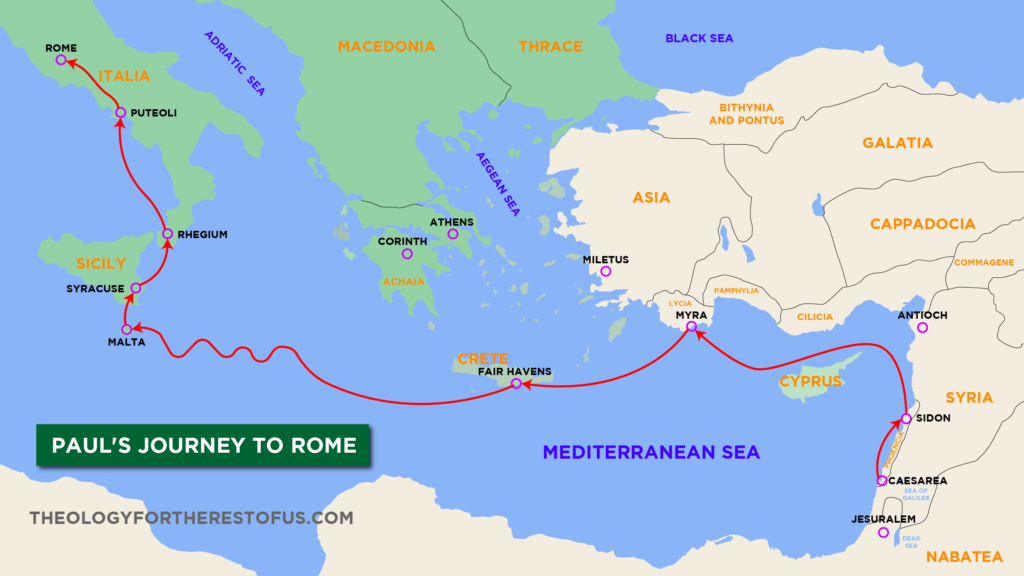
After his appeal to Rome, the apostle Paul is transported from Caesarea to Rome by ship under Roman guard (Acts 27:1-28:10). Some Bible scholars allude to this journey as Paul’s fourth missionary journey, but I don’t believe that’s the best or most accurate description for this trip.
Paul’s trip to Rome was tumultuous, filled with difficulties, including a shipwreck that caused him to be deserted on the island of Malta for three months. He also consistently faced belligerent resistance from people that opposed the gospel.
Paul and his companions eventually made it to Rome, sometime around 61 A.D. (or maybe somewhat earlier). When Paul arrived in Rome, he was placed under house arrest for two years.
Paul lived in a rented house where he served his house arrest. There he is able to visit with friends and preach the gospel to those who visit. During this time he also writes several letters that are now in the New Testament, including Philippians, Ephesians, Colossians, and Philemon.
The book of Acts ends there, with Paul under house arrest in Rome (Acts 28:11-31).
Paul’s Fourth Missionary Journey
The fourth missionary journey is not outlined in the narratives of Scripture. And there are some scholars that question whether such a journey ever really happened (we’ll cover that a bit more later in this article).
We don’t have a clear picture of what happened next in Paul’s life, after he was released from house arrest. But by carefully examining Paul’s epistles, I’m confident we can piece-it-together.
The early church father and historian Eusebius (writing in the 4th century) recorded that the most prominent church tradition had been that Paul was released from Roman house arrest and then re-arrested several years. According to this tradition, Paul’s second arrest eventually led to his martyrdom under the direction of Emperor Nero (see H.E. 2.22.6 ).
Also, Paul’s later letters (1 & 2 Timothy and Titus), commonly referred to as the Pastoral Epistles, are clearly written after the events of the book of Acts. In those letters Paul makes comments about his travels and plans. Paul is likely released from house arrest sometime around 63 A.D.
During his house arrest in Rome, Paul was clearly making plans to travel eastward. He asks Philemon to prepare a guest room for him (Philemon 22) and tells the Philippians that he intends to visit them (Phil. 2:24). Paul doesn’t strike me as the type of guy that would make plans in vain. Paul anticipated his release from house arrest.
These plans to go east make perfect sense. Paul’s habit was to go back and encourage the churches that he had previously established. That’s what he’d done on previous journeys.
Then, in 2 Timothy, written much later in life, during Paul’s second imprisonment, Paul mentions and alludes to people and moments that are connected to his post-Roman arrest ministry travels through Asia. He’s sort of looking back on past events and correspondences. Paul mentions:
- Having a significant dispute with some believers in Asia, including Phygelus and Hermogenes (2 Tim. 1:15)
- Receiving help from Onesiphorus (2 Tim. 1:18)
- Having been with Carpus at Troas (2 Tim 4:13-14)
- Being confronted by Alexander the coppersmith (2 Tim. 4:14)
- Needing to leave Trophimus in Miletus because he was ill (2 Tim 4:20)
All of these events happened after Paul’s release from Roman house arrest.
Paul says in 2 Timothy 4:20 that “Erastus remained at Corinth.” This is a clear statement that Paul had been in Corinth; he knew Erastus was there because he had first-hand knowledge, having recently visited the city.
In Titus 3:12, Paul invites Titus to join Paul in Nicopolis. Paul tells Titus that he plans on spending the winter in Nicopolis, a city in Achaia. Clearly, when Paul writes the letter to Titus he is already in Achaia or somewhere very close, hoping for Titus to meet him there.
In Paul’s letter to Titus, he alludes to having been in Crete and having left Titus in charge to help those churches flourish.
A few scholars have argued that Paul did ministry in Crete when he was shipwrecked there. Paul had been briefly shipwrecked in Crete while traveling from Caesarea to Rome, before his Roman house arrest (Acts 27).
However, Paul and the men from the shipwreck were in Crete just a short while. As we examine the events of the shipwreck, as they are described in the book of Acts, we see that Paul would not likely have had the opportunity to establish churches in the region during such a short period. Also, they didn’t travel throughout the island at all.
What seems much more likely is that Paul eventually made it back to the island of Crete, spend time preaching, establishing churches throughout the region, and that upon his departure Paul left Titus there to “complete [their] work there and appoint elders in each town” (Titus 1:5).
At the beginning of 1 Timothy Paul says “when I was going to Macedonia” (1 Timothy 1:3). When we examine this letter, we get the sense that he’s referring to events in the not-too-distant past. Seems likely Paul is referring to the moment when he had traveling to Macedonia after being released from Roman house arrest. After his time spent in Macedonia, he may have headed back to the church in Ephesus, which he asserted was his plan (1 Timothy).
Doubts about the Fourth Journey
There are clearly some comments in Paul’s letters that do not easily square with the events of the book of Acts, which means that those comments in his letters point to some missionary work that happened after Paul’s Roman house arrest.
However, a few scholars have argued that there’s significant (enough) overlap in the locations, types of events, and even the people mentioned during Paul’s first three journeys, therefore it’s hard to say for sure—they claim it’s possible that much of those things that do not seem to square with the events of the book of Acts can still potentially be things that happened on one of his first three missionary journeys.
Also, some scholars have sought to remind us that the apostle Paul spent long periods of time in some locations (like 18 months in Corinth and 3 years in Ephesus), and they’ve asserted it’s possible that many unrecorded things may have happened during those long stays, implying that those longer stays in those locations could account for some of the comments in Paul’s epistles.
These scholars claim there’s so much that we do not know about those time periods, that it’s entirely possible all of the events alluded to by Paul, in his own letters, took place during his first three journeys.
I happen to be confident that Paul did indeed take a fourth missionary journey, after his release from his Roman house arrest. I think that’s the best interpretation of the data we have. However, I also realize that there are some good New Testament scholars that don’t find the evidence as compelling as I do.
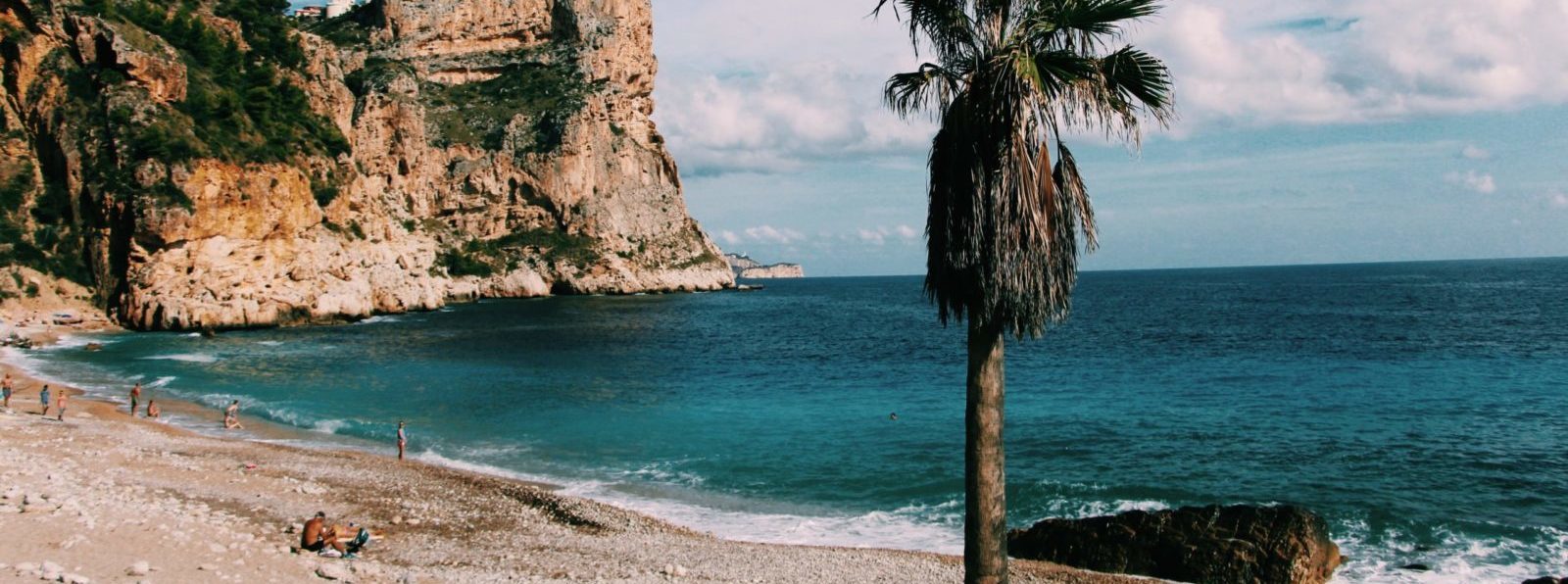
Potential Travel to Spain
Did Paul ever make it to Spain? We know from Scripture that the apostle Paul had a desire to preach in Spain (Rom. 15:22-29). After being released from Roman house arrest, he could have easily sailed westward.
Clement of Rome (writing in 95 A.D.) says that Paul had traveled and preached in “the farthest limits of the West” (1 Clement 5:5-7). This sort of language could have described a location west of Italy, such as Gaul or Britannia, but most scholars seem to think this describes Spain. However, it is also possible that Clement was speaking more broadly (or generically), referring to Paul traveling far westward from his home region, going from Palestine through much of the heart of the Roman Empire and eventually all the way to Rome. This latter interpretation seems odd to me.
The Muratorian fragment (written in apx. 170 A.D.), seems to affirm Paul’s missionary journey to Spain too, but some scholars question this; just because someone in the mid-to-late second century believed it doesn’t necessarily equate to strong evidence. However, this shows that church tradition was handing this down through the generations.
Paul’s missionary trip to Spain is also mentioned by Cyril of Jerusalem (313-386) and John Chrysostom (347-407).
There may not seem to be many significant (quality) pieces of evidence that corroborate the idea that Paul made it all the way to Spain, and there are not any comments in Paul’s later letters that point to him ever making it to Spain either. However, these extrabiblical evidences seem compelling. It’s possible that a trip to Spain may have been the first leg of Paul’s fourth missionary journey.
Paul Beheaded by Nero
In his second letter to Timothy, Paul mentions his “first defense” and says he was “delivered from the lion’s mouth” (2 Tim. 4:16-17). Most biblical scholars believe this is a reference to the first time he was in Caesar’s court, defending himself, eventually leading to his Roman house arrest (Acts 28).
Paul was released from his first Roman arrest, but there wouldn’t be a second release. Paul eventually ended up back in Rome. The second time, it wasn’t house arrest. It was a real Roman jail. This was most likely part of Nero’s persecution of Christians in the mid 60s. This was one of the most brutal times of persecution in Christian history.
When much of the city of Rome burndown in 64 A.D., Emperor Nero blamed the Christians. The emperor later requested that the apostle Paul be arrested and chained. It appears that Paul was arrested somewhat abruptly and unexpectedly, evidenced by the fact that he was not able to secure his cloak and his Old Testament parchments; Paul later requested that these be brought to him (2 Tim. 4).
Paul likely penned 2 Timothy during this second Roman imprisonment. Paul was beheaded shortly after he wrote 2 Timothy. Some scholars have concluded that Paul was killed as early as 64 A.D., but it is more likely that he was executed sometime between 67 A.D. and 68 A.D.
The legacy of the apostle Paul is second to none in Christian history. He is the greatest missionary evangelist the world has ever seen. Paul was a man on mission, focused on spreading the gospel and planting churches.
Paul was a man so impacted by Jesus, so compelled by God’s love, so humbled that the Messiah would choose him to be an ambassador, that he was willing to endure much pain and hardship to see others come to faith in Jesus Christ.
Featured illustration of Paul in prison courtesy of britannica.com. Images of the jails in Philippi and Caesarea courtesy of missionbibleclass.org. Illustration of Eutychus’ death courtesy of gfbtkingdomkids.com.
Recommended Resources:
“Handbook on Acts and Paul’s Letters” (by Thomas R. Schreiner)
“Paul: A Biography” (by N.T. Wright)
“Acts: An Expositional Commentary” (by R.C. Sproul)
“Dictionary of Paul and His Letters” (more than 100 contributors, edited by Gerald Hawthorne, Ralph Martin, and Daniel Reid)

Kenneth E. Ortiz (Th.M.) is Lead Pastor of Horizon City Church . He has 15+ years of vocational ministry experience. Kenneth previously served as a professor at Bethlehem College and adjunct faculty at Spurgeon College . Kenneth lives in Minneola, FL with his wife Malaina, they have two kids.


This video is part of a series of 4 animated maps.
▶ view series: history of christianity, the apostle paul's missionary journeys.
This map is part of a series of 4 animated maps showing the history of History of Christianity.
Paul, known as the 13th apostle, was the most successful disciple in opening the new Christian Church to the ‘Gentiles’ that is the non-Jews.
His journeys bear witness to the spread of Judeo-Christianity beyond Palestine by the middle of the first century. They are described in the Acts of the Apostles, although there are sometimes discrepancies between the various accounts.
The first voyage lasted from 45 to 49 AD, and Paul was accompanied by two other evangelists, Barnabas and John Mark. After leaving Antioch, the three men apparently went to Cyprus and then travelled to Asia Minor. In particular, they visited Perga, Pisidian Antioch, and then Derbe. Their return journey followed the same route as far as Perga, where they sailed directly to Antioch.
For his second voyage, Paul travelled with Silas, a member of the Christian community in Jerusalem, probably between 50 and 52 AD. After leaving Antioch, Paul crossed Asia Minor via Tarsus, Lystra, Pisidian Antioch, to the port of Troas. He then sailed to Macedonia and, from there travelled to Greece, where he stayed for a while in Athens and Corinth. The next stage of his journey took him to Ephesus, where he boarded a ship for Antioch, visiting Caeserea on the way.
During his third voyage, between 53 and 58 AD, Paul again travelled across Asia Minor. He probably stayed in Ephesus for three years and then made a second visit to communities in Macedonia and Greece. On his return journey, he stayed a while in Miletus and Rhodes before travelling to Tyre and Caesarea and returning to Jerusalem. Here, he was arrested at the request of the Jewish authorities between 58 and 60 AD.
Paul was sent to Rome for judgment, where there was already a thriving Judeo-Christian community. Little is known about the date and circumstances of his death. It might have occurred in 64 AD, shortly after Rome was destroyed by fire, or a few years later in 67 AD.
A quick guide to St. Paul’s travels according to today’s map
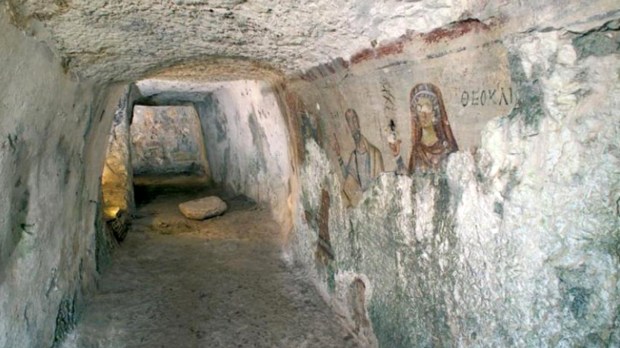
Ephesus Foundation USA
Please consider a gift for Aleteia! Help us spread the joy of Christ's victory. Aleteia depends on your support.
Join our Lenten Campaign 2024.

A comprehensive map of all the journeys taken by St. Paul in his lifetime is yet to be completed . But what we know for sure is that Paul, who used to be called by his Jewish name Saul of Tarsus before converting to Christianity, spent about 30 years sailing around the Mediterranean basin and visiting what were considered to be the major cities of his time.
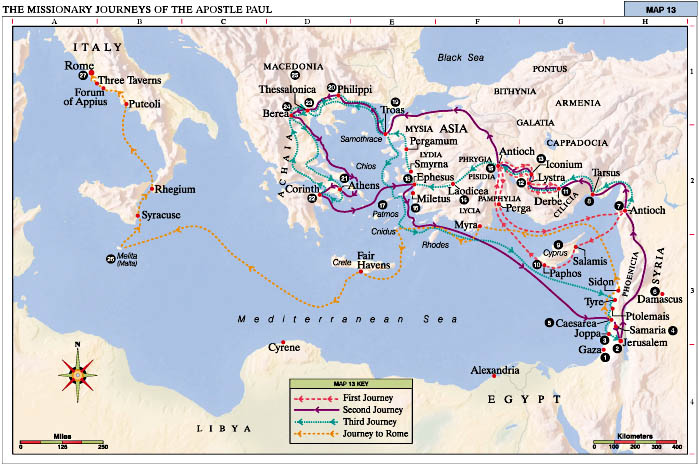
Sources disagree on an exact list of locations that Paul visited during his lifetime, but what’s sure is that during the three journeys described in Acts 13-14 , Acts 15-17 and Acts 18-20 he visited many historical cities that are considered the backbone of Western civilization. From Athens to Corinth, passing through Antioch and Ephesus, here is a summary of Paul’s travels , including an indication of where those locations are on today’s map.
What’s considered Paul’s “first journey” started in the year 45 and ended in 49 . Together with Barnabas, a Cypriot Jew converted to Christianity, Paul traveled across the island of Cyprus, Barnabas’s homeland, preaching the Gospel in several synagogues. They then set sail from Paphos, on the southwest coast of Cyprus, and reached the port of Perga, in Anatolia, modern-day Turkey.
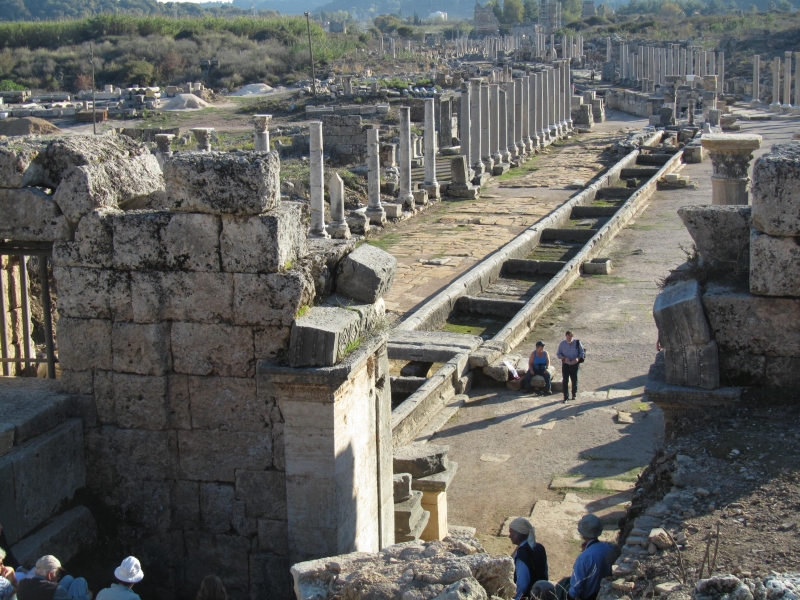
From Perga they finally reached Antioch of Pisidia, where Paul began to spread the word to the local Jewish community. Initially, his message was very well received, leading to an invitation to speak during Sabbath (the holy day), but part of the community soon turned envious about the strong popularity enjoyed by a foreign preacher and eventually managed to push Paul out of the city.
Paul and Barnabas then left for Konya, a city just south of Ankara, in present-day Turkey, but were forced to leave again, this time for the nearby town of Lystra. Here Paul healed a sick man and the local pagan community began to believe he was sent by God. But soon enough, the same people who contested him in Konya reached Lystra and instigated a group of locals to stone Paul, forcing him to flee. He then reached the city of Derbe, also in modern-day Turkey, and from there back to Lystra, Konya and finally Antioch of Syria on the Orontes, a city of ancient Syria now in modern-day Turkey, where his journey originated. Here Paul reports that, through his message, many pagans got to know the word of God.
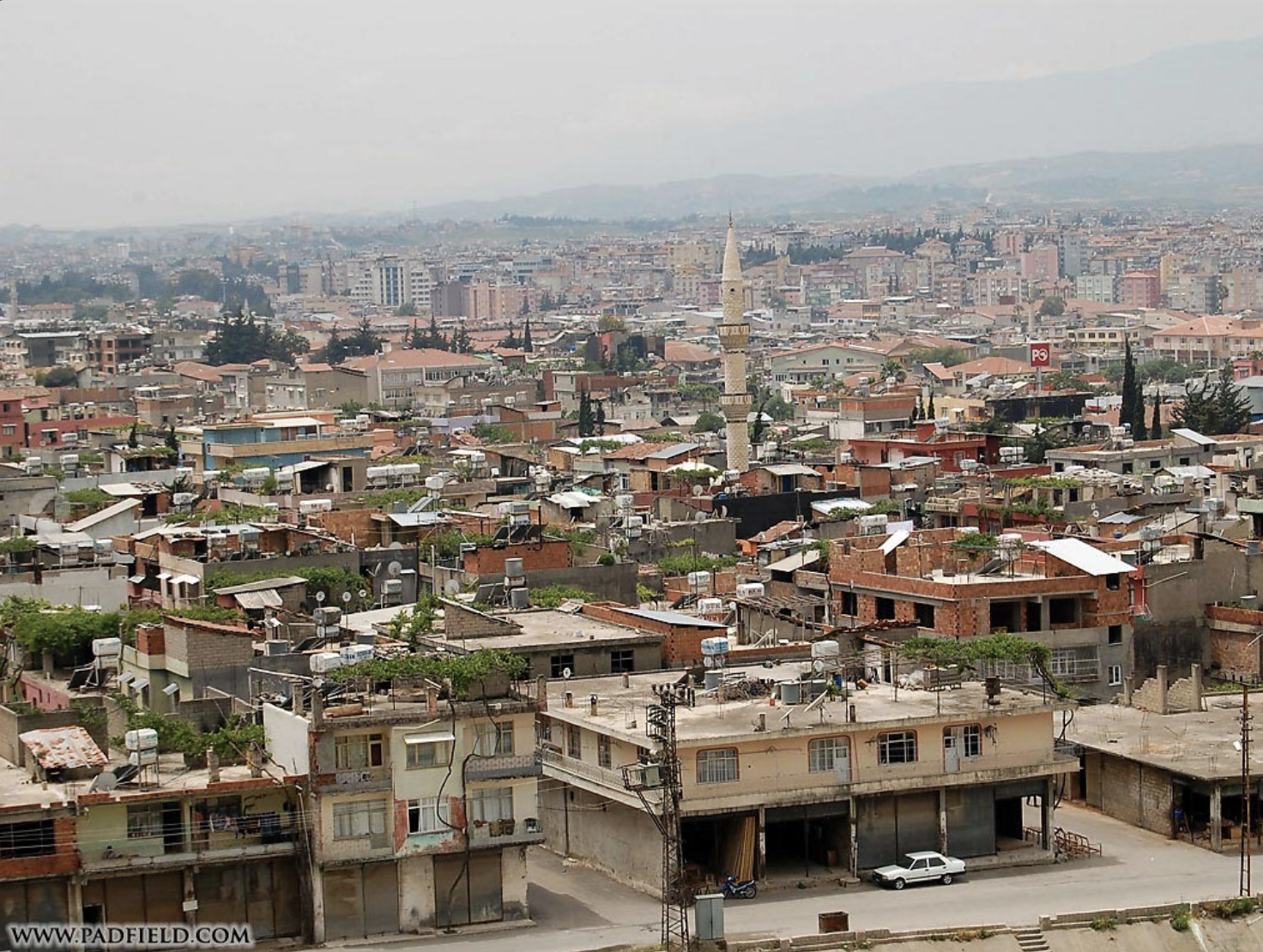
Second trip
Paul’s second journey started in the year 49 and ended in 52 . This time, Paul hit the road to check back on those early Christian communities he helped found during his first trip.
He was accompanied by Silas, a leading member of the early Christian community, and Timothy, the son of a Greek man who was a dear companion to Paul. The group headed to Lystra, then through Phrygia, an ancient kingdom on the Sangarios River in modern day Turkey; then to Galatia, an area in the highlands of central Anatolia, also in present-day Turkey, that was inhabited by Gallic people of the Hellenistic period, and finally to Troad, a city in north-west Anatolia, present-day Turkey.
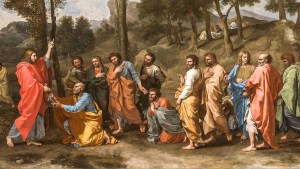
Here, Paul had a vision of a man asking him to bring the Gospel to Macedonia , and then set off to reach the European mainland for the first time. By way of Samothrace, a Greek island in the northern Aegean Sea, and Neapolis, known today as the Greek city of Kavala, they reached Philippi, a Roman city in the first district of Macedonia, which today stands as one of Greece’s UNESCO World Heritage Sites.
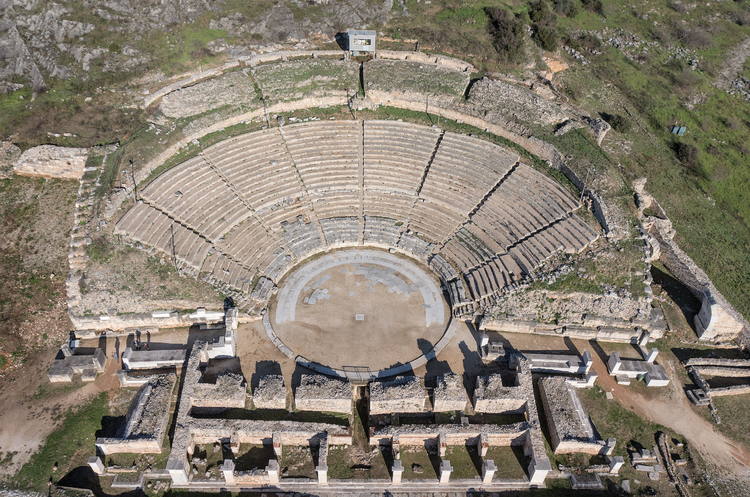
Here, Paul was hosted by Lydia, a woman who worked as a dealer in purple cloth from the city of Thyatira. But soon enough, a group of hostile locals pushed authorities to arrest Paul and his companions. However, thanks to a providential earthquake, the group managed to escape Philippi’s jail. Eventually, local magistrates learned that Paul and his travel companions were Roman citizens and officially let them free. The Philippian community soon grew to become an important Christian center, to which Paul later addressed the Epistle of Paul to the Philippians.
After Philippi, the group reached Thessaloniki, in present-day northern Greece, where they were hosted by Jason, a Jewish man who had converted to Christianity. Here, even if his mission was somehow successful, Paul was quickly forced to leave after a group of local Jews reported his evangelization activities to local pagan authorities.
They then left for Berea, an important port city, now known as Veria, in Macedonia, north of Greece, but the same group that kicked them out of Thessaloniki soon caught up with them and pushed them to leave Berea as well.
The group hit the road once again and reached Athens, which had been severely damaged by Roman attacks in 146 B.C. but was still considered the capital of philosophy and knowledge of what was then the known world. Here Paul engaged in conversation with many public intellectuals in both synagogues and public squares and was eventually invited to give a speech to Athenian citizens from the Aeropago , a marble hill just above the Acropolis. According to Luke (Act 17, 11-33) it is here that Paul proclaimed his famous speech about “the Unknown God” to to the pagan thinkers of Athens.
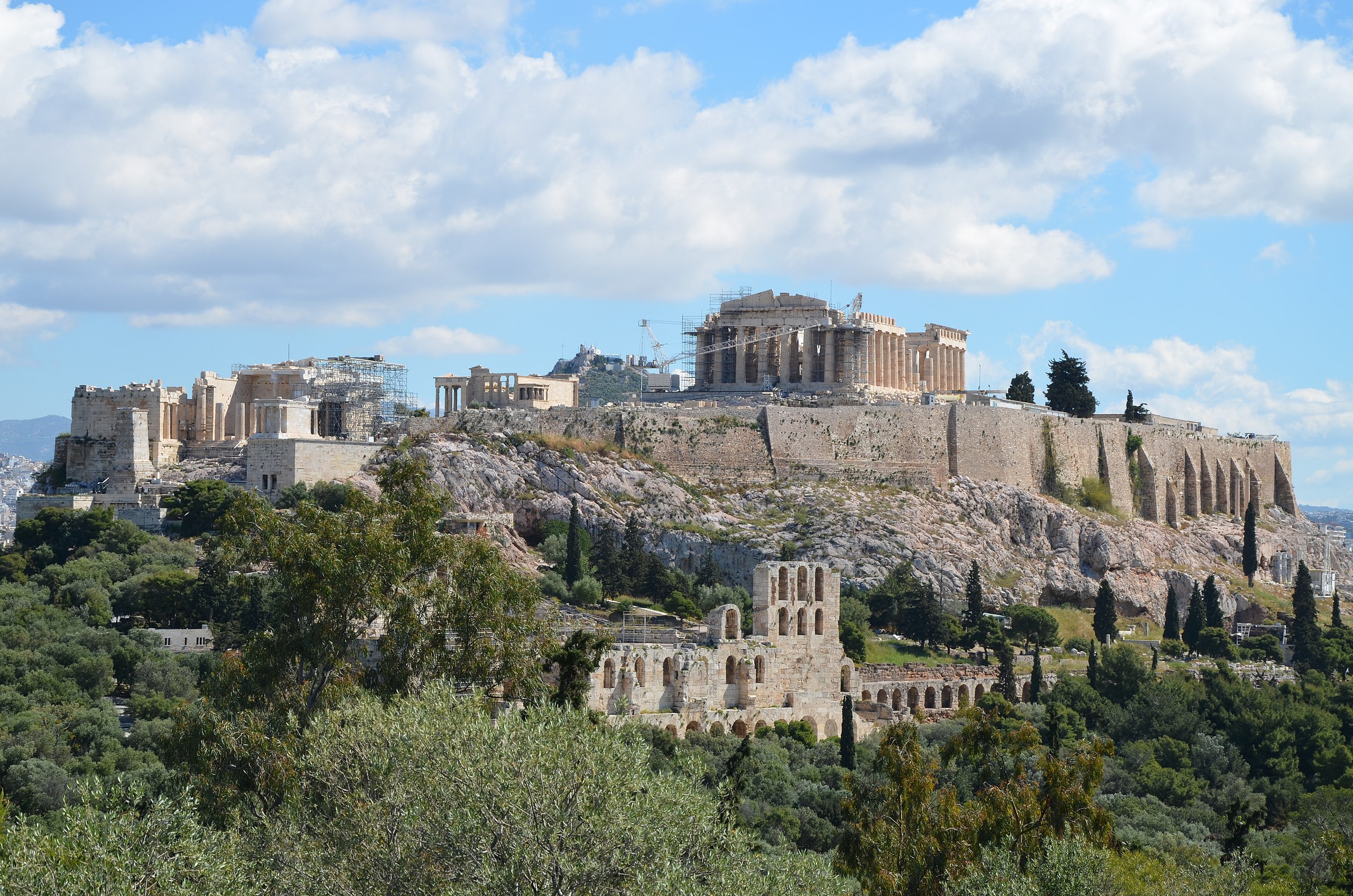
From Athens, Paul headed to Corinth, capital of the Roman province of Acaia in present-day south-central Greece. Here he stayed with the married Christian couple Priscilla and Aquila , who had been exiled by the Roman emperor Claudius in 49-50. In Corinth Paul engaged in prolific speeches that led to many conversions, but he was subject to hostility from groups of local Jews. However, Roman pro-consul Gallio adopted a neutral stance regarding Paul religious mission and decided to let him free.
Together with Priscilla and Aquila, Paul set sail for Syria and reached Ephesus and from here Caesarea, in modern day north-central Israel, and eventually back to Antioch.
Third journey
Paul’s third journey took place between 52 and 57 . He first headed back to Galatia and Phrygia to check on the communities he helped set up during his previous trips. He then set sail for Ephesus , an ancient Greek city in present-day Turkey, which at the time was the capital of the Roman province of Asia and home to the famous temple of Artemis-Diana, which was considered one of the seven wonders of the world. Here Paul baptized 12 disciples who had previously received a penitential baptism by John the Baptist, and together with companions he helped evangelize nearly all the local inhabitants.
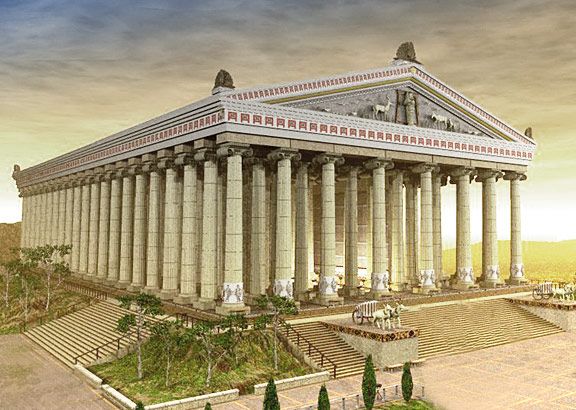
After a winter break in Corinth, Paul headed back to Ephesus , but hostility from local Jews forced him to leave for Antioch, Syria. From here he departed for more Greek cities—including the islands of Lesbos and Samos—and reaches Miletus, in modern-day Turkey.
Here he pronounced his famous speech dedicated to the “Ephesian elders, ” in which he recommended that the leaders of the communities he helped found take on his mission and preserve the values of vigilance, disinterest and charity. In 58, Paul decided to head toward Jerusalem , so he set off on an arduous sailing trip that made stops at a new harbor almost each day, including the islands of Kos and Rhodes in modern-day Greece. He finally reached Jerusalem where he stayed with Mnason of Cyprus, one of the people he helped convert on one of his early trips.
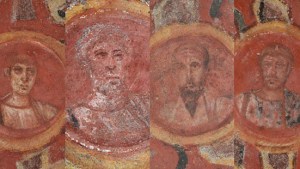
Paul then visited James, who advised him to talk to the most traditionalist Jews at the Temple. Here Paul was recognized by the Jews of Asian provinces, and once again faced hostility. Claudius Lysias, the local Roman tribune, intervened and put Paul in jail before even knowing that he is a Roman citizen. This was the start of what many refer to as the “Passion Pauli,” in which St. Paul’s dedication to his evangelization mission led to his arrest, beating, torture, and eventual death in Rome at the order of Emperor Nero in 62-64.
Make sure to visit the slideshow below to discover some of the greatest works of art representing the Road to Damascus, the decisive moment in the life of Paul, the Apostle to the Gentiles.
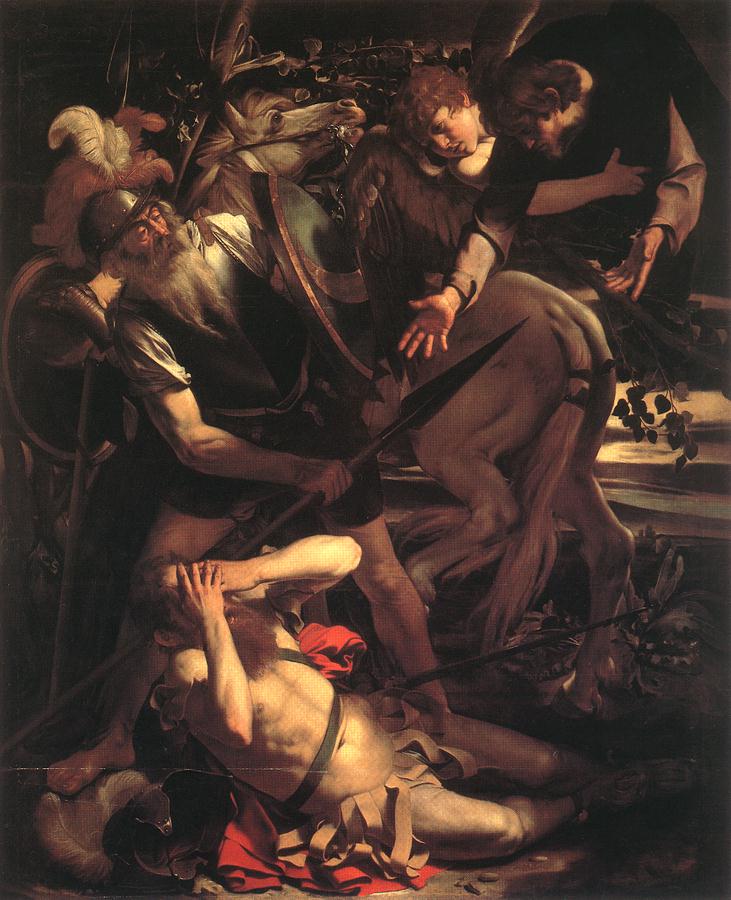
Articles like these are sponsored free for every Catholic through the support of generous readers just like you.
Help us continue to bring the Gospel to people everywhere through uplifting Catholic news, stories, spirituality, and more.

Teach Me Thy Way
Bible resources for the home and classroom
Paul’s Missionary Journey Maps and Photos
- Pinterest 22

Paul’s Missionary Journey Maps and Photos Bundle is one of the most popular resources at Teach Me Thy Way, and I’m excited to share it with you! It’s so important that our children understand that Bible stories are unlike the fairy tales and fictional books that we read. The Bible is truth, and it is full of the history of real people and places!

With a fervent love for Jesus and a passion for spreading the good news, Paul traveled thousands of miles on his journeys. He crossed land and sea, and he faced unthinkable circumstances while doing so. In 2 Corinthians 11:25-27, Paul stated,
“Three times I was beaten with rods, once I was stoned, three times I was shipwrecked, a night and a day I have spent adrift at sea. I have been on frequent journeys, in dangers from rivers, dangers from robbers, dangers from my countrymen, dangers from the Gentiles, dangers in the city, dangers in the wilderness, dangers at sea, dangers among false brothers; I have been in labor and hardship, through many sleepless nights, in hunger and thirst, often without food, in cold and exposure.”
Bringing Paul’s Journeys to Life

Stoning, shipwrecks, and danger! The stories of Paul’s journeys are captivating for learners of all ages. However, it’s crucial that our most precious students understand that Bible stories are like none other . These are true events involving real people with eternal souls.
It is my hope that this resource enriches student understanding of Paul’s journeys by helping students to see that these are true events that occurred in real places! We may not be able to travel to all of these faraway lands or see them with our own eyes. However, in a small way, we can using engaging visuals.
What does Paul’s Missionary Journey Maps and Photos Bundle Include?
The bundle includes three Teach Me Thy Way products:
- First Missionary Journey of Paul Map Set
- Second Missionary Journey of Paul Map Set
- Third Missionary Journey of Paul Map Set

The Google Drive PDFs follow the route of Paul on his missionary journeys, and each file includes a map and modern day photos of his stops. Each photo is labeled with both the Biblical name and the modern day name of the city or area.

More Missionary Journey Resources
If you are looking for classroom activities for Paul’s journeys, check out Paul’s Missionary Journeys Map Worksheets . These engaging worksheets will lead your learners through each preaching trip as they use map skills to follow the timeline of events!
- Map Paul’s First Missionary Journey Worksheets
- Map Paul’s Second Missionary Journey Worksheets
- Map Paul’s Third Missionary Journey Worksheets
- Paul’s Missionary Journeys Map Bundle
STAY CONNECTED AND GET ALL THE LATEST

I hope you’ll find these resources helpful for your family! For more Bible resources, visit my shop here ! You can also find Teach Me Thy Way on Teachers Pay Teachers and Etsy .
Please do not distribute your digital downloads to others. Each purchase includes one digital license for the use of a single classroom or a single family home. This practice helps to keep prices affordable for all teachers. Contact me for pricing an organizational license. An organizational license can be shared among teachers of a single school, church, or other organization for the use in multiple classrooms.
Similar Posts

Exploring Divisions of the Bible Bookmarks
Hey, friends! I’ve got something exciting to share with you today that I hope will help your learners with a bit of memory work. I’m thrilled to add our affordable Divisions of the Bible Bookmarks to the shop! These little gems have been a hit on our Teachers Pay Teachers store, and now we’re bringing…

Resources for Bible Teaching Teams
Hey there, fellow teachers. Let’s share the love with our Bible teaching teams! At Teach Me Thy Way, we’re all about making Bible resources accessible for both students and teachers. That’s why we’re thrilled to introduce our range of products that come with organizational licenses! These licenses allow multiple teachers within a school, church, co-op,…

Tips for Teachers on a Budget: Fun and Frugal Advice
Hey there, fellow teachers! Are you like me, spending a lot of time scrolling through Pinterest, marveling at all the wonderful and creative teaching ideas? The problem is, as amazing as those ideas are, they often come with a hefty price tag. But no worries! Whether y’all are new teachers or veteran teachers, I’m here…

Bible Story Resources: 17 Periods of Bible History
Hey there! Get ready for an exciting journey through the Bible as we explore the 17 Periods of Bible History. So, grab a cup of coffee, get cozy, and let’s dive into this amazing adventure! I’m thrilled to share two fresh Bible Story resources based on the 17 periods of history. And guess what? One…

Strategies for Teaching a Nonverbal Student with Autism
Hey there, teacher friends! I hope you are all embracing the joy of sharing the word of God with your sweet students. Today, I wanted to dive into a topic that deserves some special attention: strategies for teaching students with disabilities, including nonverbal students with autism spectrum disorder. Now, I know this can be a…

Letter Writing Interactive Bulletin Board
I first created the Letter Writing Interactive Bulletin Board to use within our own church family as we were studying the Letters of Paul in Bible classes. However, as I watched our children grow in encouraging and edifying others, I decided to share it with you! Why were letters written during the first century? Before…
Leave a Reply Cancel reply
Your email address will not be published. Required fields are marked *
Save my name, email, and website in this browser for the next time I comment.
The Missionary Journeys of Paul
Description, scripture references, related collections.

IMAGES
VIDEO
COMMENTS
Paul is likely arrested and imprisoned in Rome in the early part of 68 A.D. In the spring he writes his last book, 2Timothy, addressed to his greatest friend (Life and Epistles of St. Paul, appendix III). 68 A.D. Paul is beheaded, under Roman Emperor Nero, around May or June. His death occurs just before Nero's suicide on June 9, 68 A.D. in Greece.
51-53 A.D. Paul's Second Missionary Journey is recorded in Acts 16, 17 and 18. Paul and Barnabas separate over a disagreement on whether or not to take John Mark on this second evangelistic voyage, because he had left them during the first journey. Eventually, Barnabas decided to take John Mark to Cyprus with him, while Paul took Silas to ...
Paul's missionary journeys helped spread the gospel throughout much of the ancient world. Over the course of his ministry, the Apostle Paul traveled more than 10,000 miles and established at least 14 churches.. The Book of Acts records three separate missionary journeys that took Paul through Greece, Turkey, Syria, and numerous regions you won't find on modern-day maps.
Map of Paul's journey to Rome. Around 59 A.D. and 60 A.D., Paul the evangelist was taken as a prisoner from Caeserea to Rome, making several stops along the way. Even as a prisoner, he continued to evangelize. This journey is described in the Bible's book of Acts, chapters 26, 27 and 28.
Paul's Last Journeys. The definite history of the apostle Paul ends with the last verse of the Acts of the Apostles; but, from the later Epistles and the dim light of early tradition, we may gather a few facts, and perhaps can indicate a few more journeys. From Philippians and Philemon, [131] it is clear that Paul expected an acquittal and ...
The Apostle Paul is one of the most important figures in the New Testament, and his missionary journeys played a key role in spreading Christianity throughout the Mediterranean world. By exploring these journeys through maps and geography, we can gain a deeper understanding of Paul's travels and the impact they had on the early Christian church.
Explore the interactive map of Paul's Missionary Journeys, where you can see ancient and modern places overlaid with the routes of his travels. Learn more about the historical and geographical context of his ministry and zoom in to discover the roads and cities he visited.
Maps of Paul's Missionary Journeys Paul's Third Missionary Journey Paul's Journey to Rome. Rome 'Troas Pergamum Ephesus Attalí Black Sea h (Pisídían) Icon:um Lqstra Perga ar Antioch S :leucía Cyprus ap o Da cUs Caesar erusalem Macedonia essaloníc berea Mediterranean Sea
This Google Earth file series shows the approximate journeys the apostle Paul made according to the book of Acts, which can be found in the New Testament of the Bible. It shows the approximate ...
Maps of the Missionary Journey's of Paul the Apostle in the First Century A.D. The missionary voyages of the apostle Paul from Jerusalem to Rome. This map also shows much of the Roman Empire in the time of Paul and his journeys. The order which prevailed in this extensive empire, the good military roads, and the use of Koine Greek as the ...
7 Last Words of Christ Parables Jesus and the Kingdom Resurrection. Acts ... Apostle Paul - Maps of His Journeys by Dr. Ralph F. Wilson. Free E-mail Bible Study King Solomon: Wisdom, ... 2nd Missionary Journey. Paul's Second Missionary Journey 2018 ; Paul's Macedonian Ministry 2019 ...
Paul's second missionary journey lasted between two and a half years and three years, and likely ended back in Antioch sometime in the fall of 53 A.D. (or maybe early 54 A.D.). Paul's Third Missionary Journey. After getting back from his second missionary journey, the apostle Paul stayed Antioch for "some time" (Acts 18:23).
This map is part of a series of 4 animated maps showing the history of History of Christianity. Paul, known as the 13th apostle, was the most successful disciple in opening the new Christian Church to the 'Gentiles' that is the non-Jews. His journeys bear witness to the spread of Judeo-Christianity beyond Palestine by the middle of the ...
Paul traveled through Cyprus on his first missionary journey ( Acts 13:4-5 ), as did Barnabas and Mark later ( Acts 15:39 ). Paphos Paul cursed a sorcerer here ( Acts 13:6-11 ). Derbe Paul and Barnabas preached the gospel in this city ( Acts 14:6-7, 20-21 ). Lystra When Paul healed a cripple, he and Barnabas were hailed as gods.
Paul's second journey started in the year 49 and ended in 52. This time, Paul hit the road to check back on those early Christian communities he helped found during his first trip.
A new map of Paul's missionary journeys is a big upgrade from the print-based paradigm, giving you more details on demand and control over which routes are visible. The background starts with ancient Roman provinces, then reveals roads and cities as you zoom in. All of it is built with advanced tools from Mapbox for a smooth experience on any ...
Third Missionary Journey of Paul Map Set The Google Drive PDFs follow the route of Paul on his missionary journeys, and each file includes a map and modern day photos of his stops. Each photo is labeled with both the Biblical name and the modern day name of the city or area.
A map showing the missionary journeys of the Apostle Paul. Image Collections; Come, Follow Me: Learning and Teaching Resources ... Download Description. A map showing the missionary journeys of the Apostle Paul. Sources. July 22-28: Acts 16-21; Come, Follow Me—For Individuals and Families: New Testament 2019. Scripture References. Acts 16 ...
n u m i d i a a f r i c a i t a l y t r i p o l i t a n i a c y r e n a i a e g y p t a a b i a j u d e a s y r i a c a p a d o c i a t h r a c e g a l at i b i t h y ...